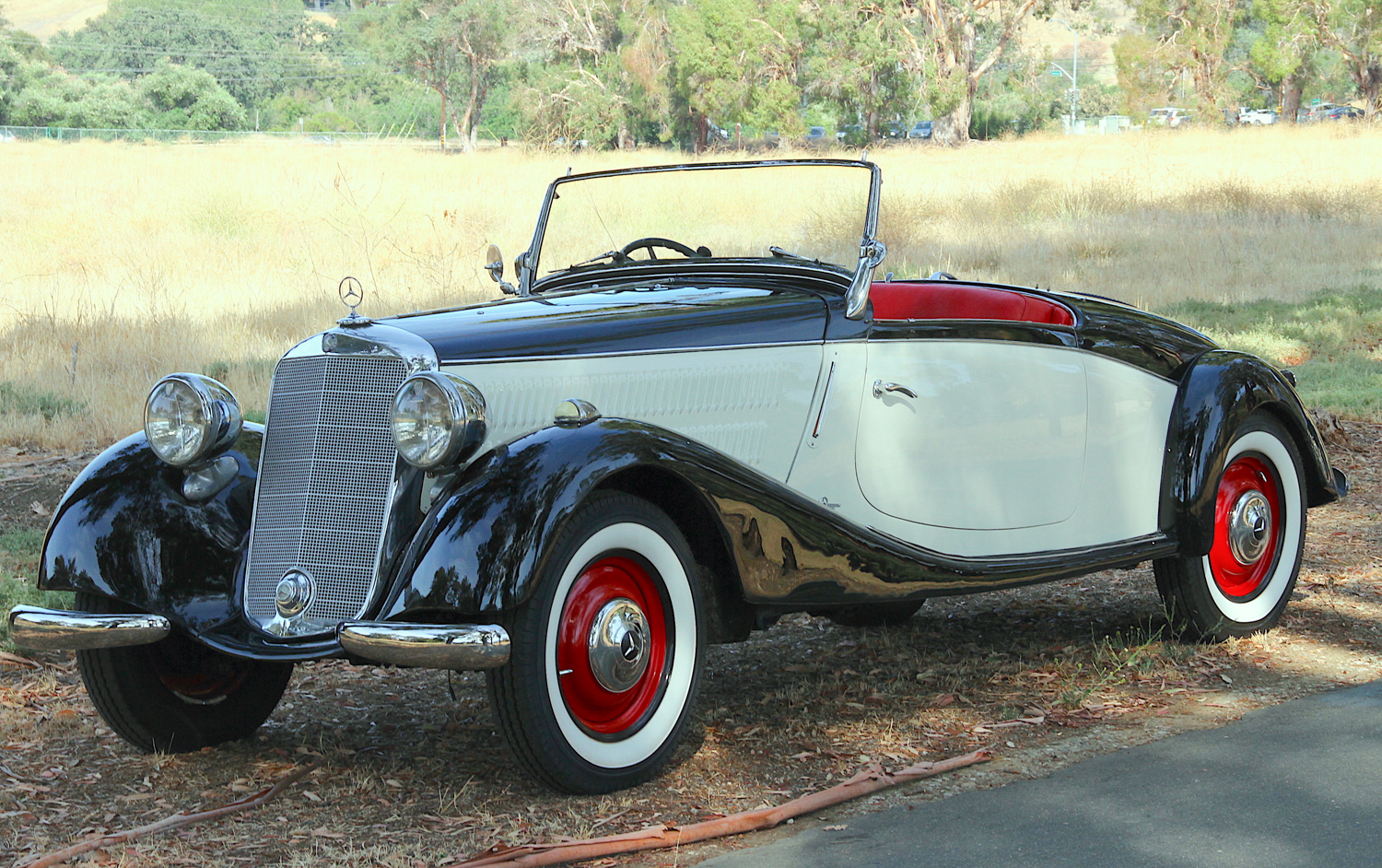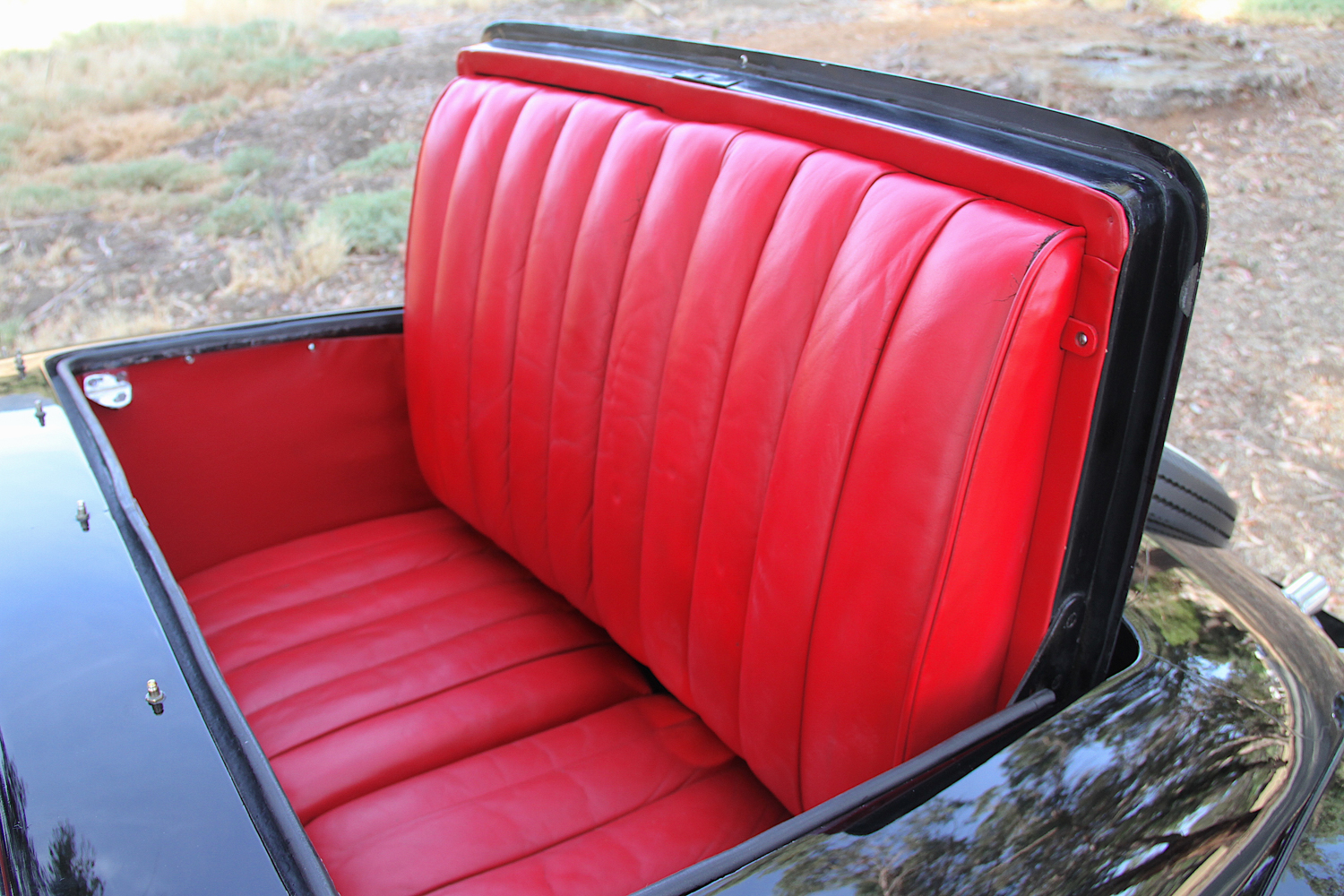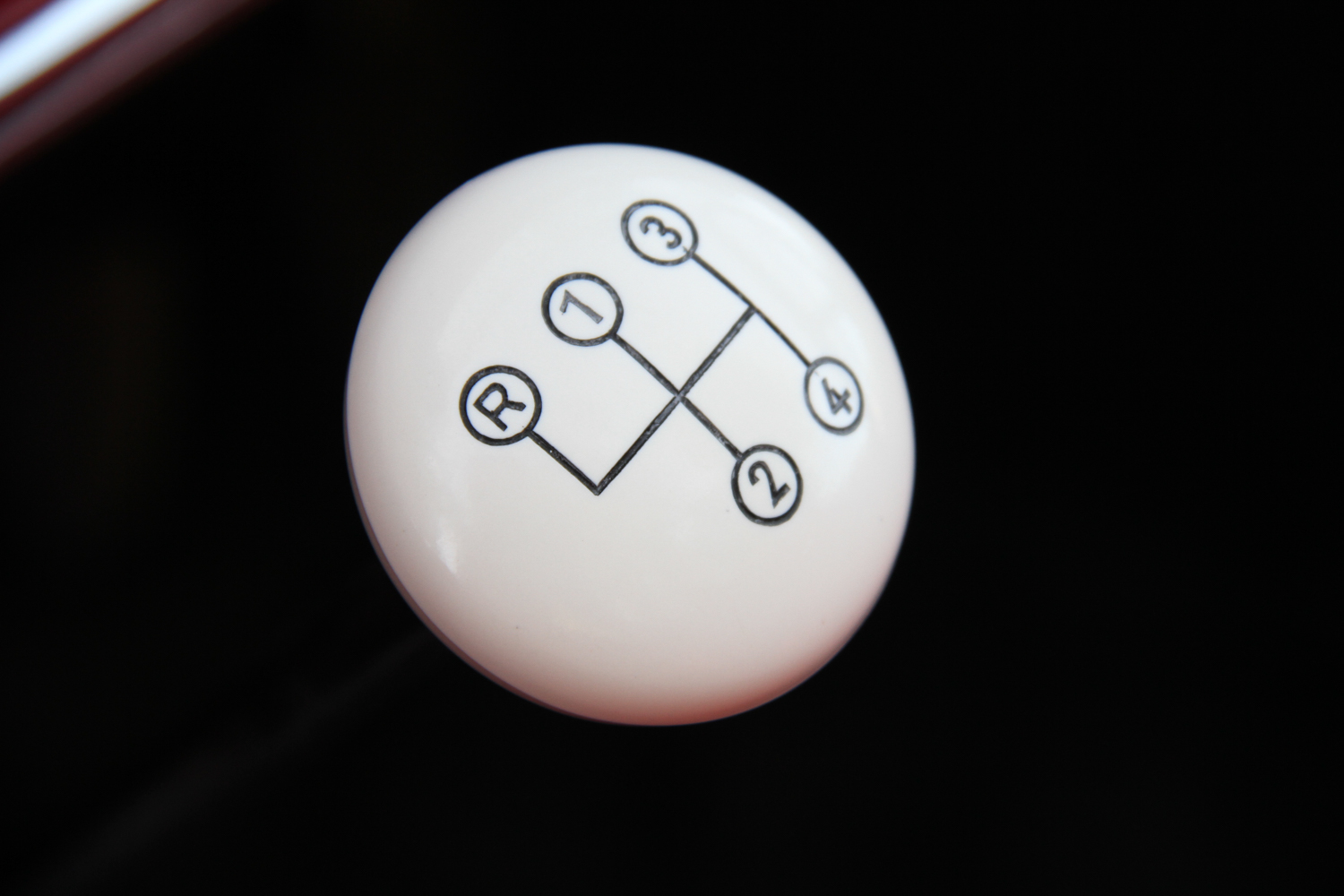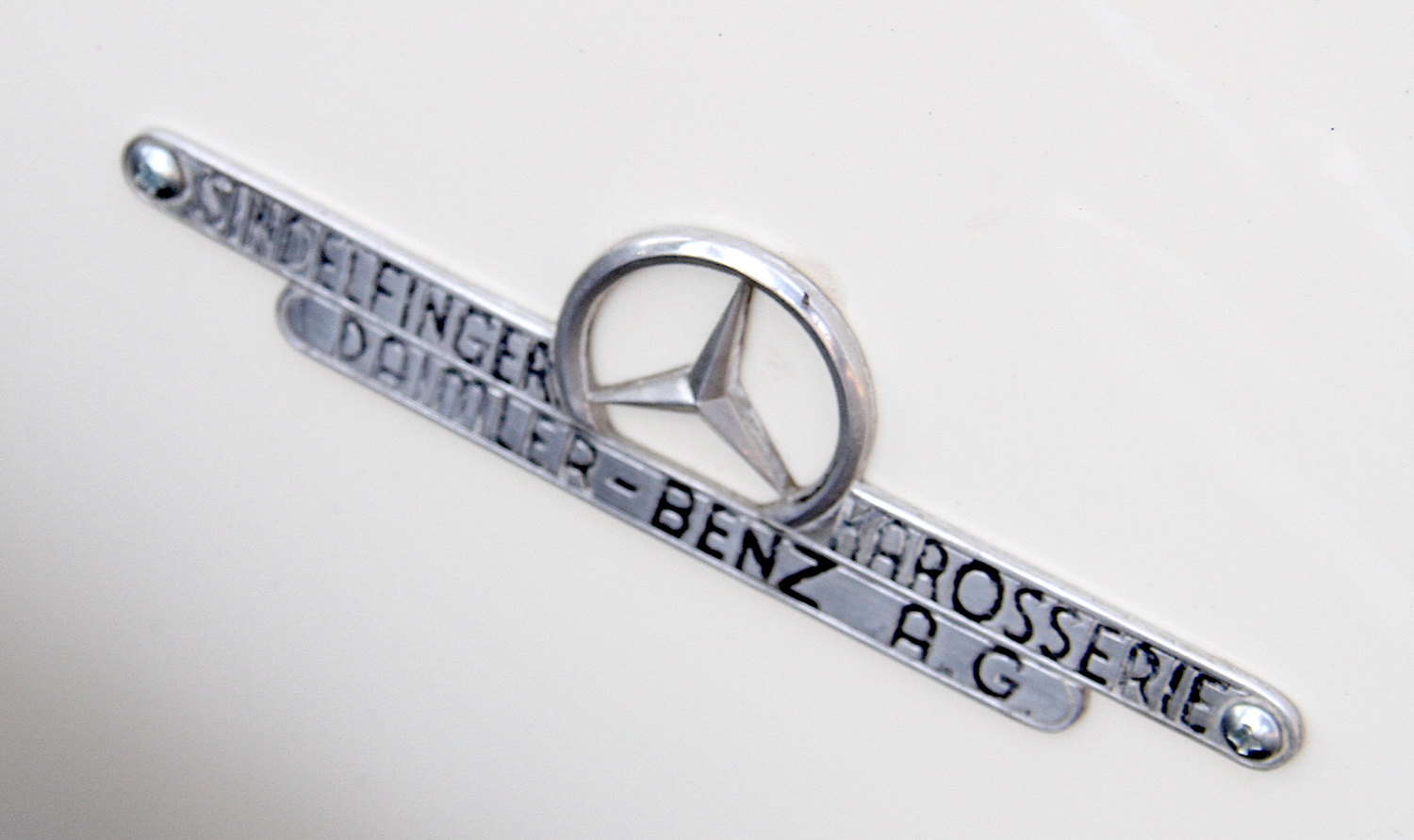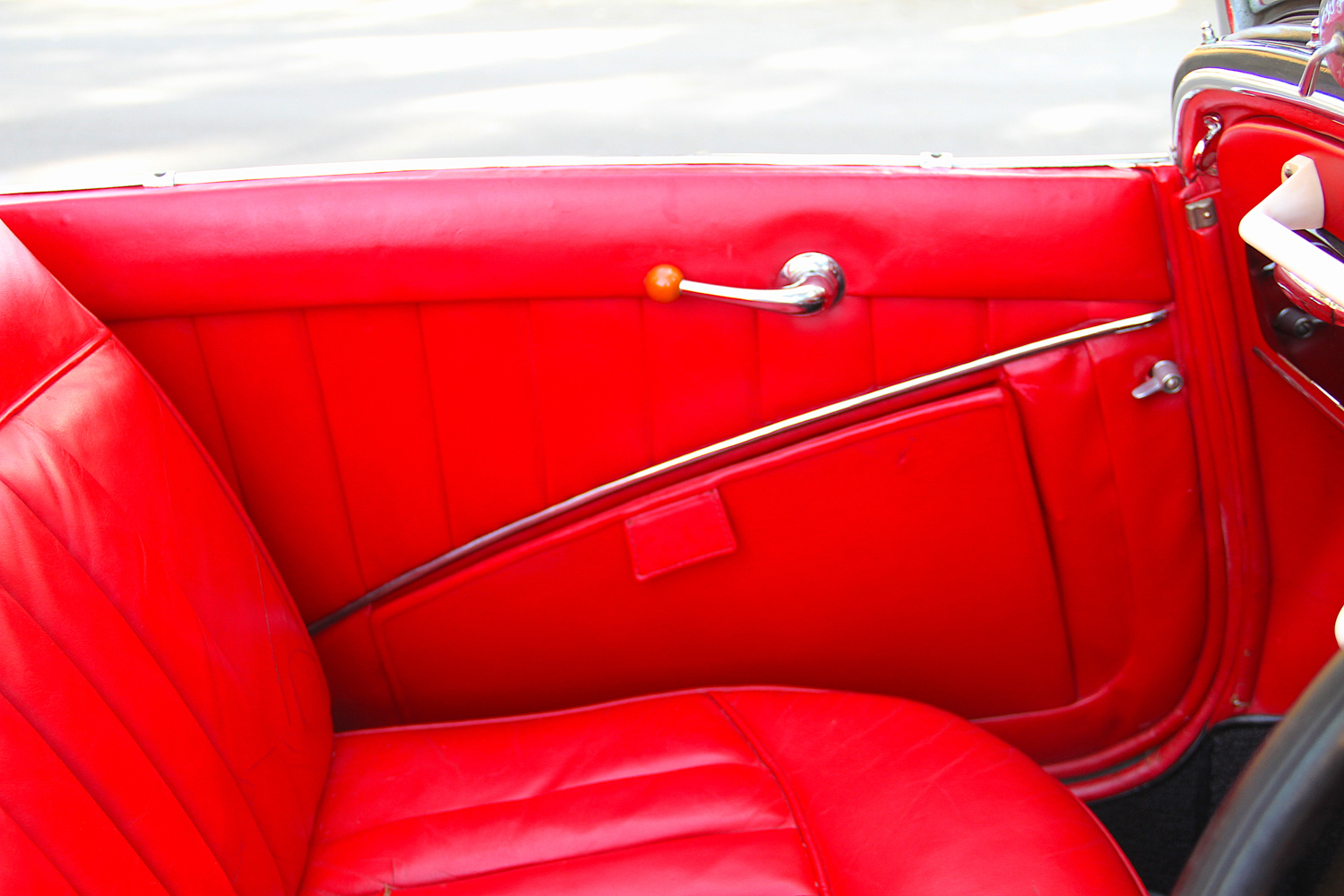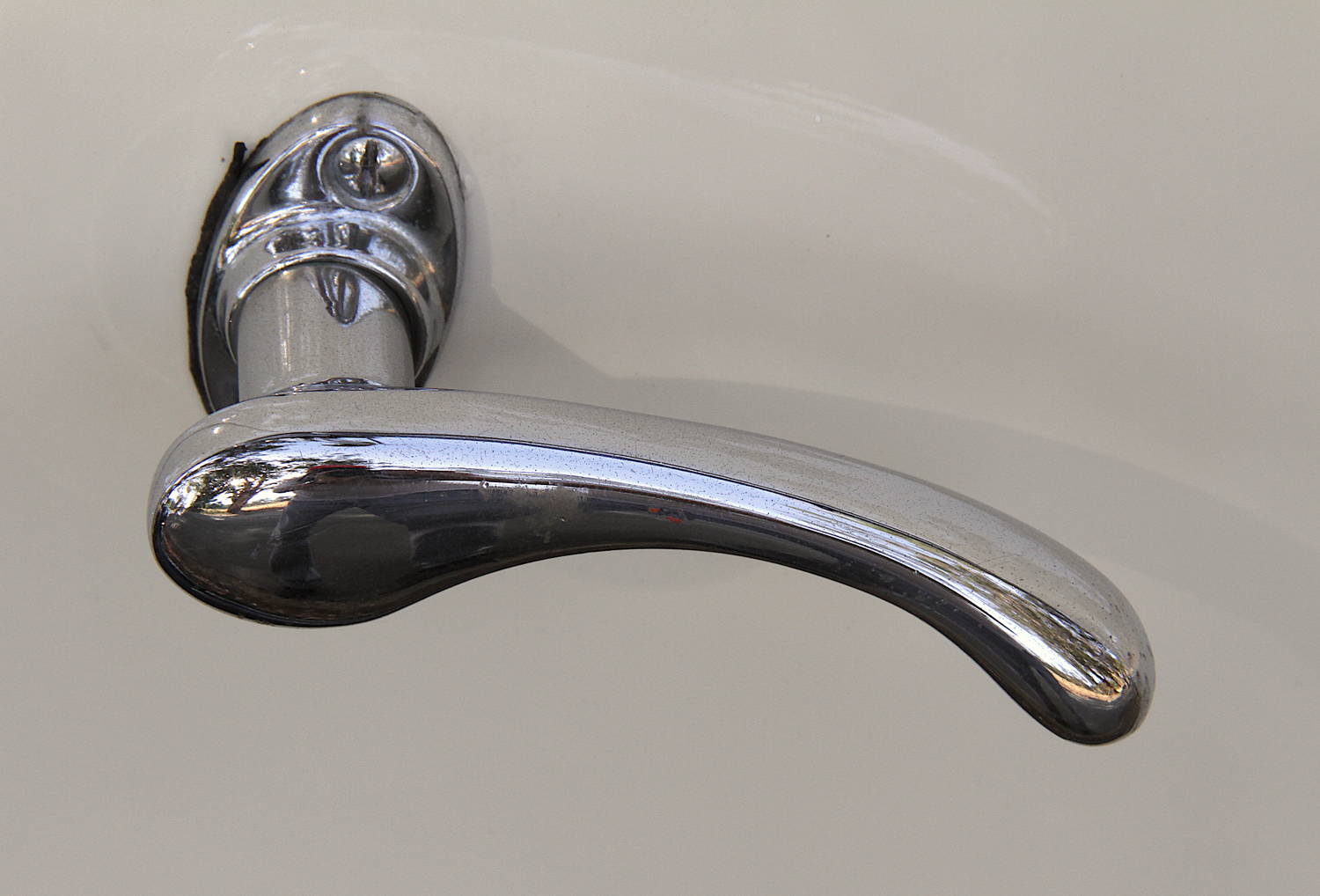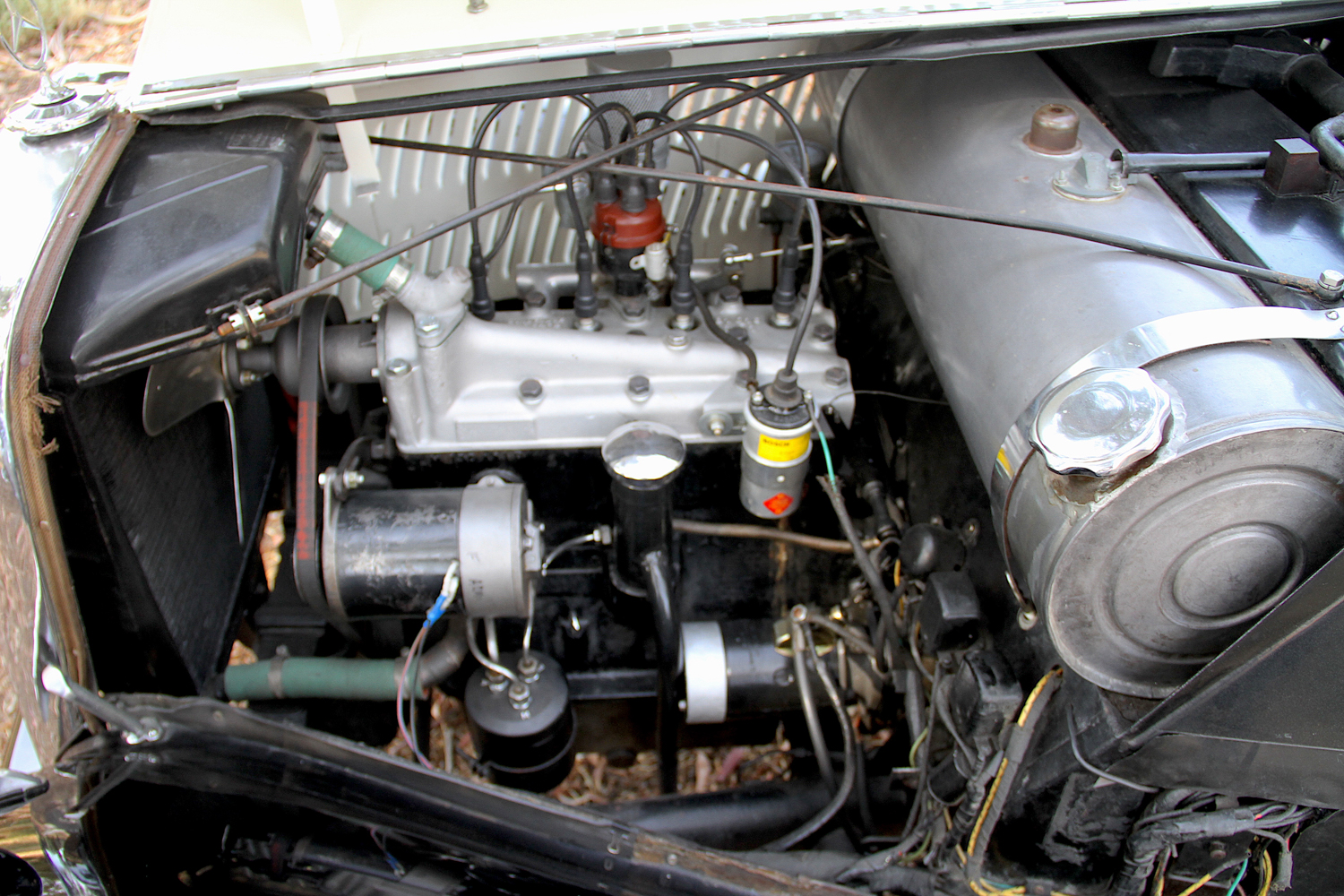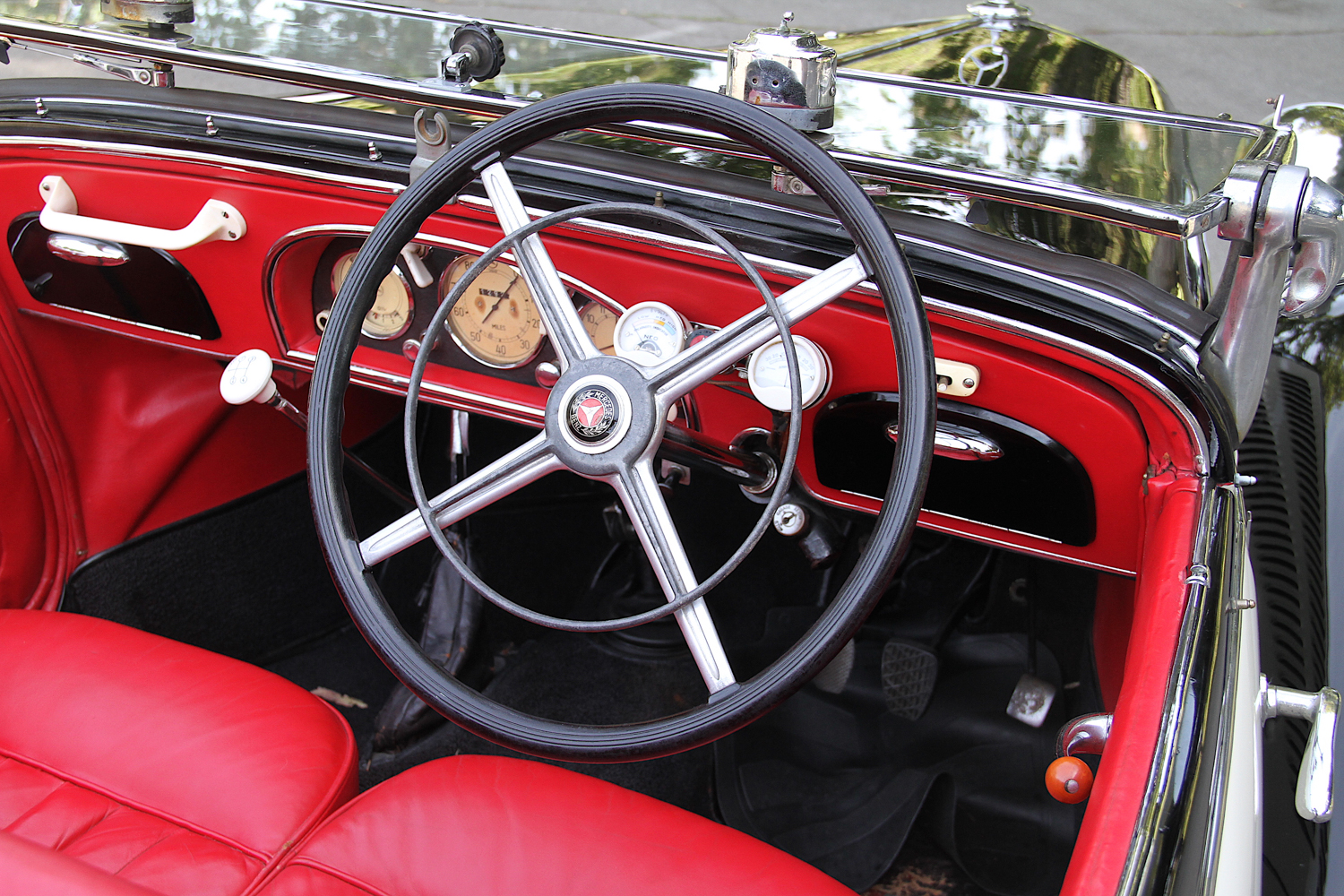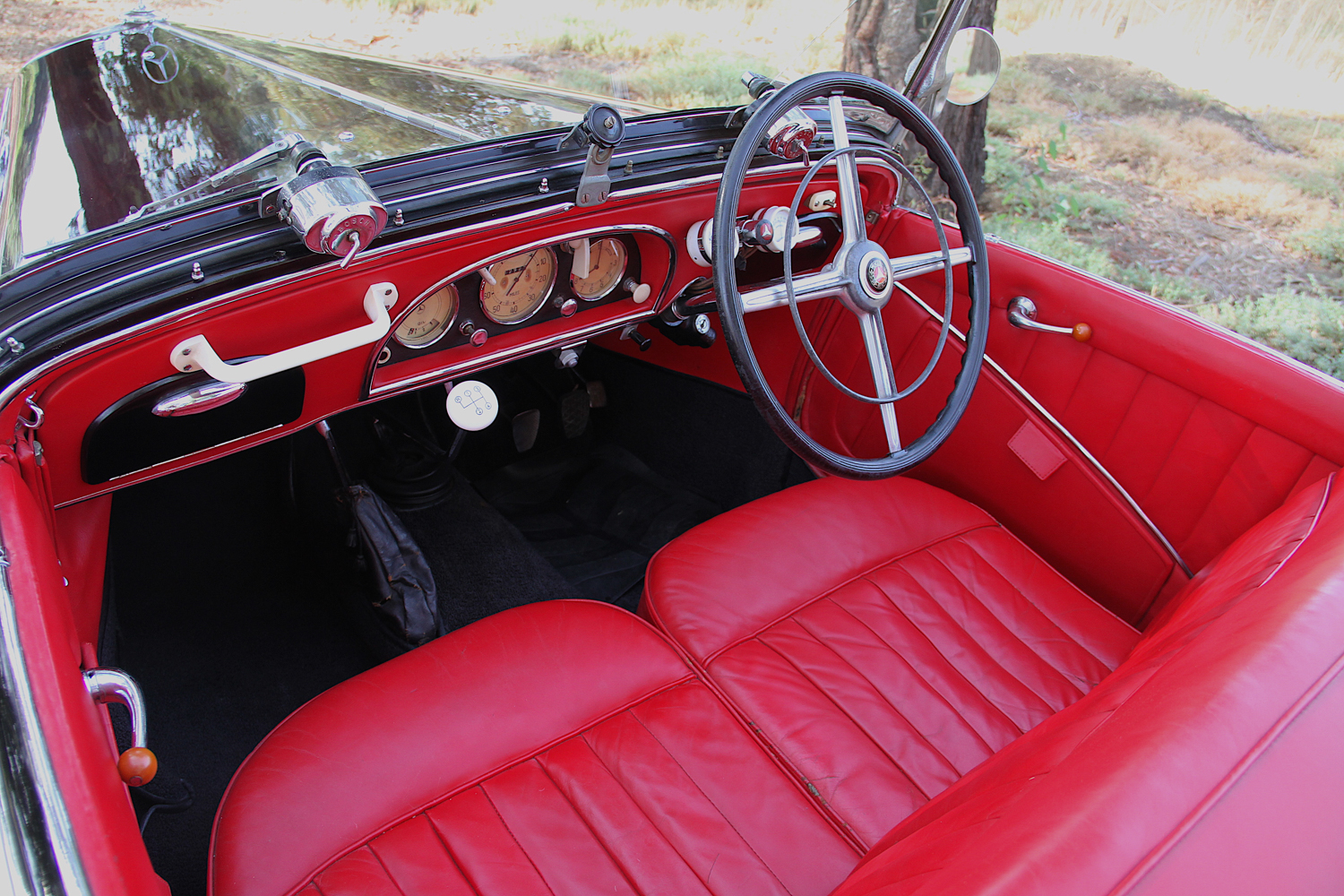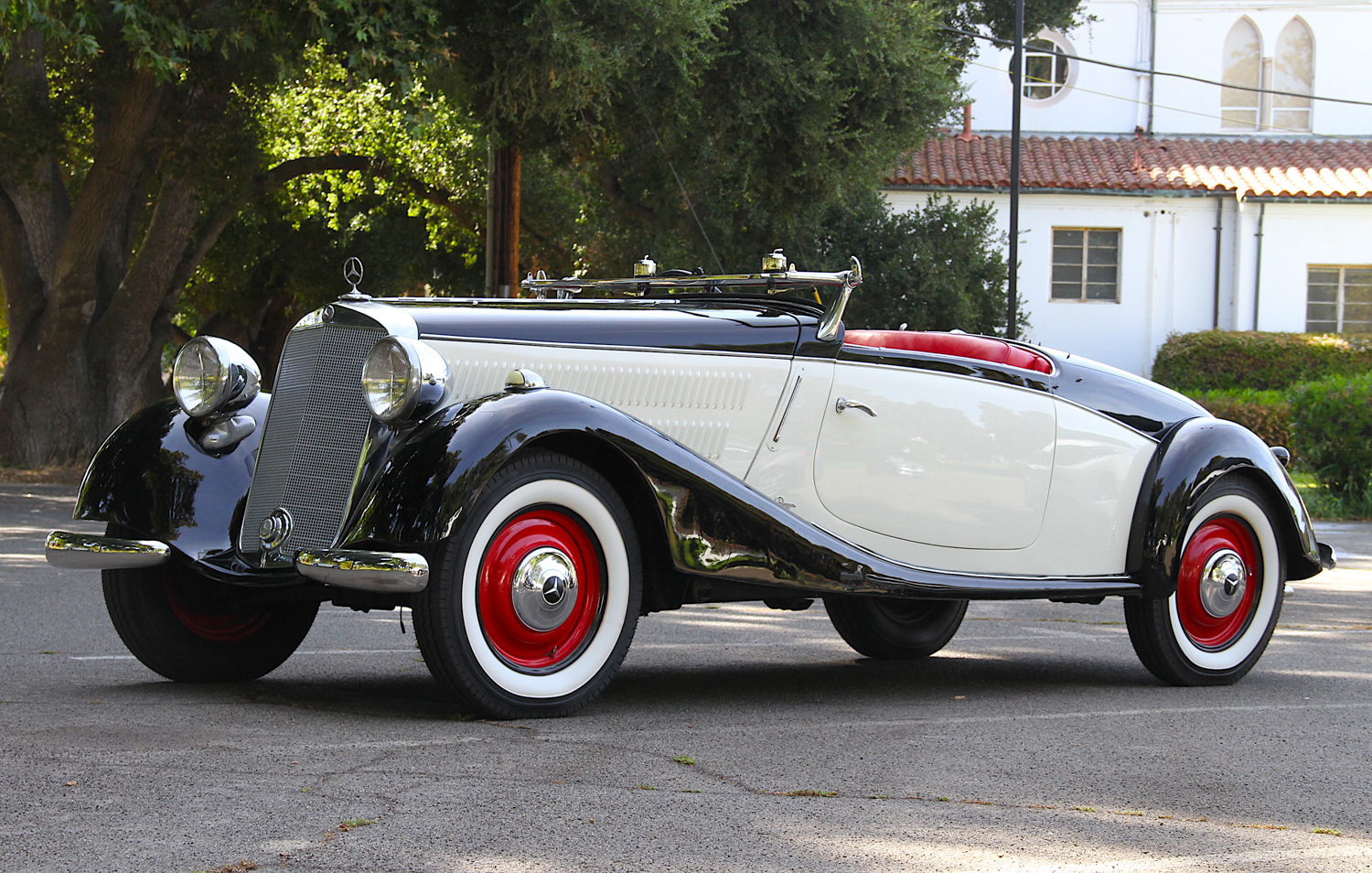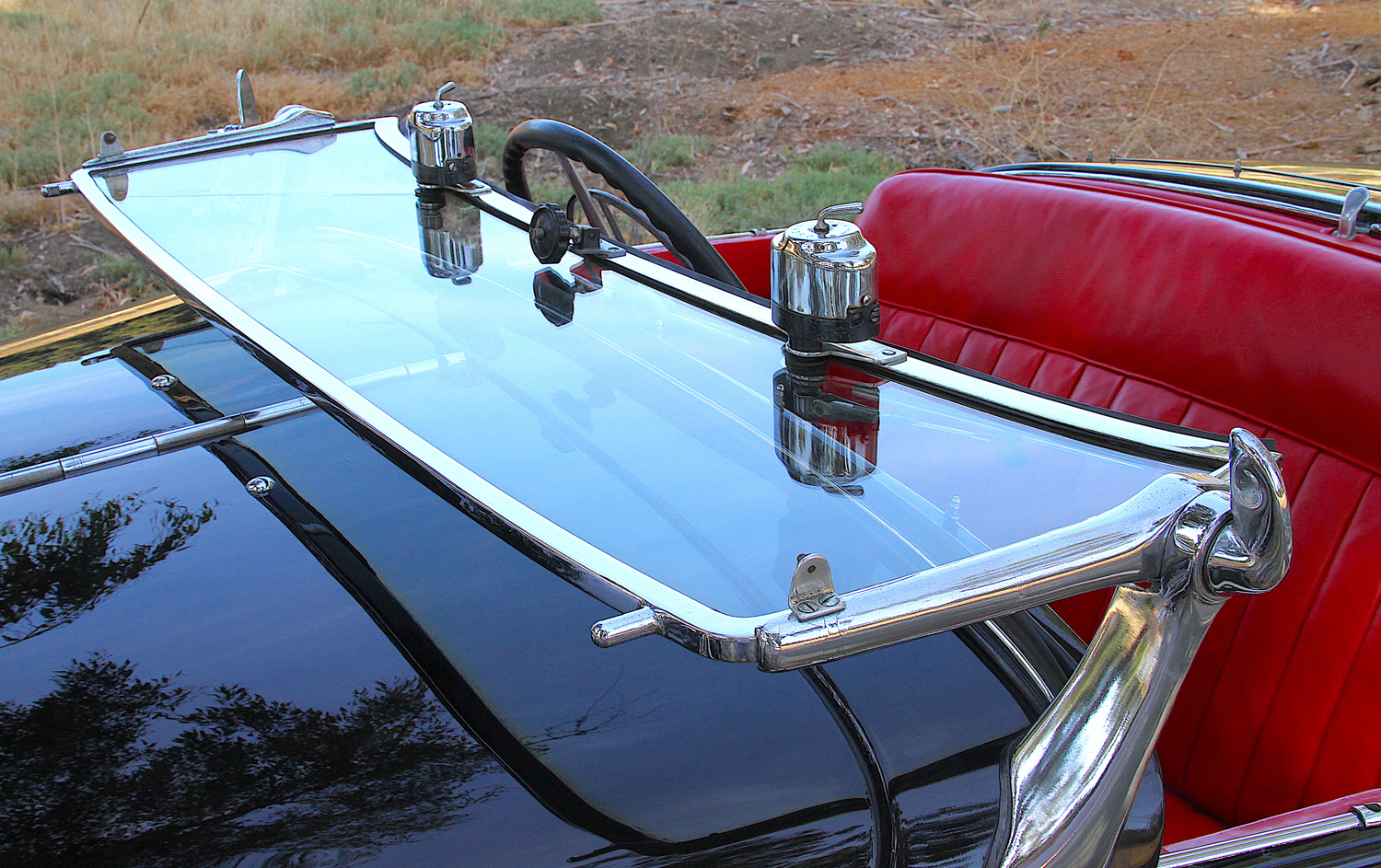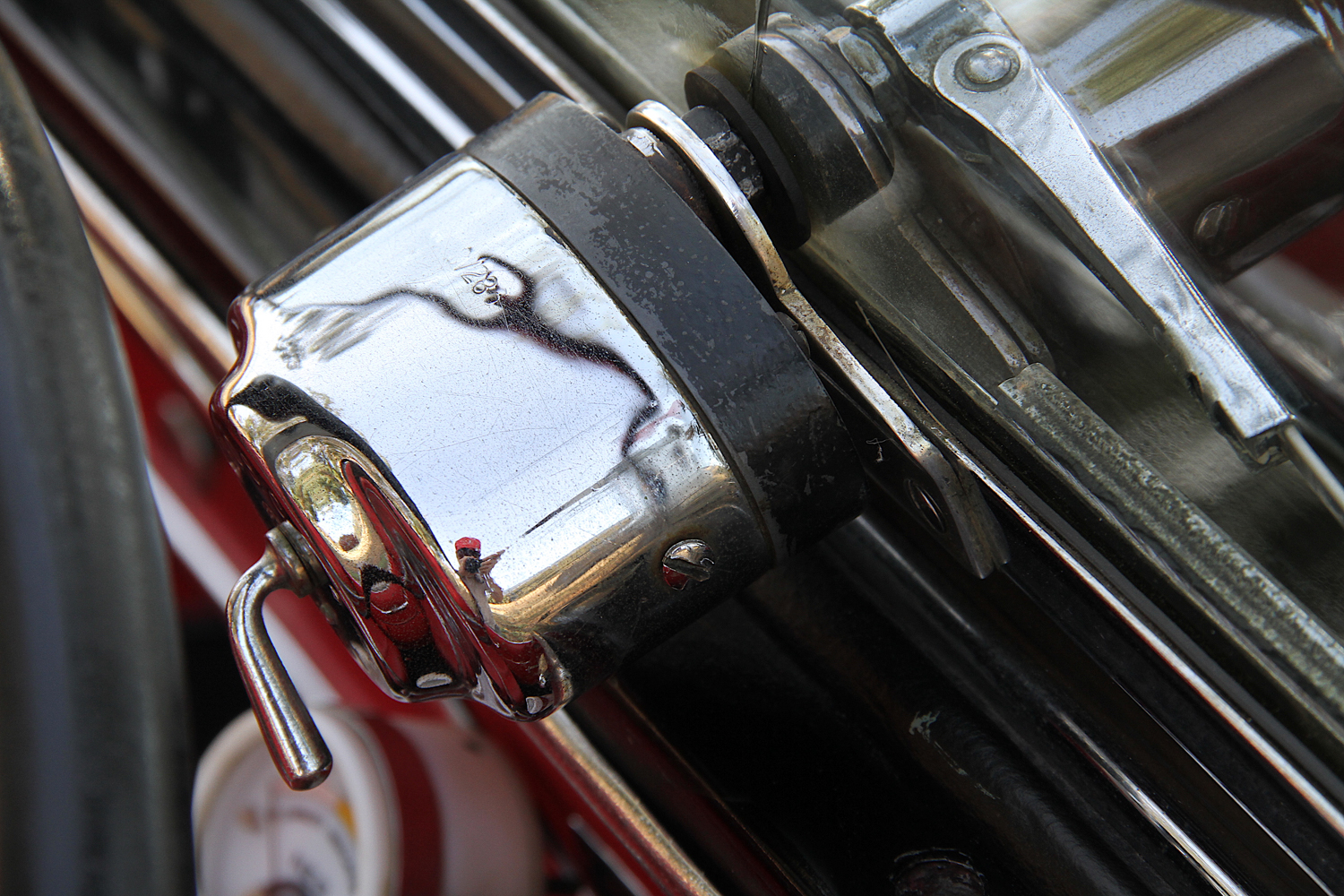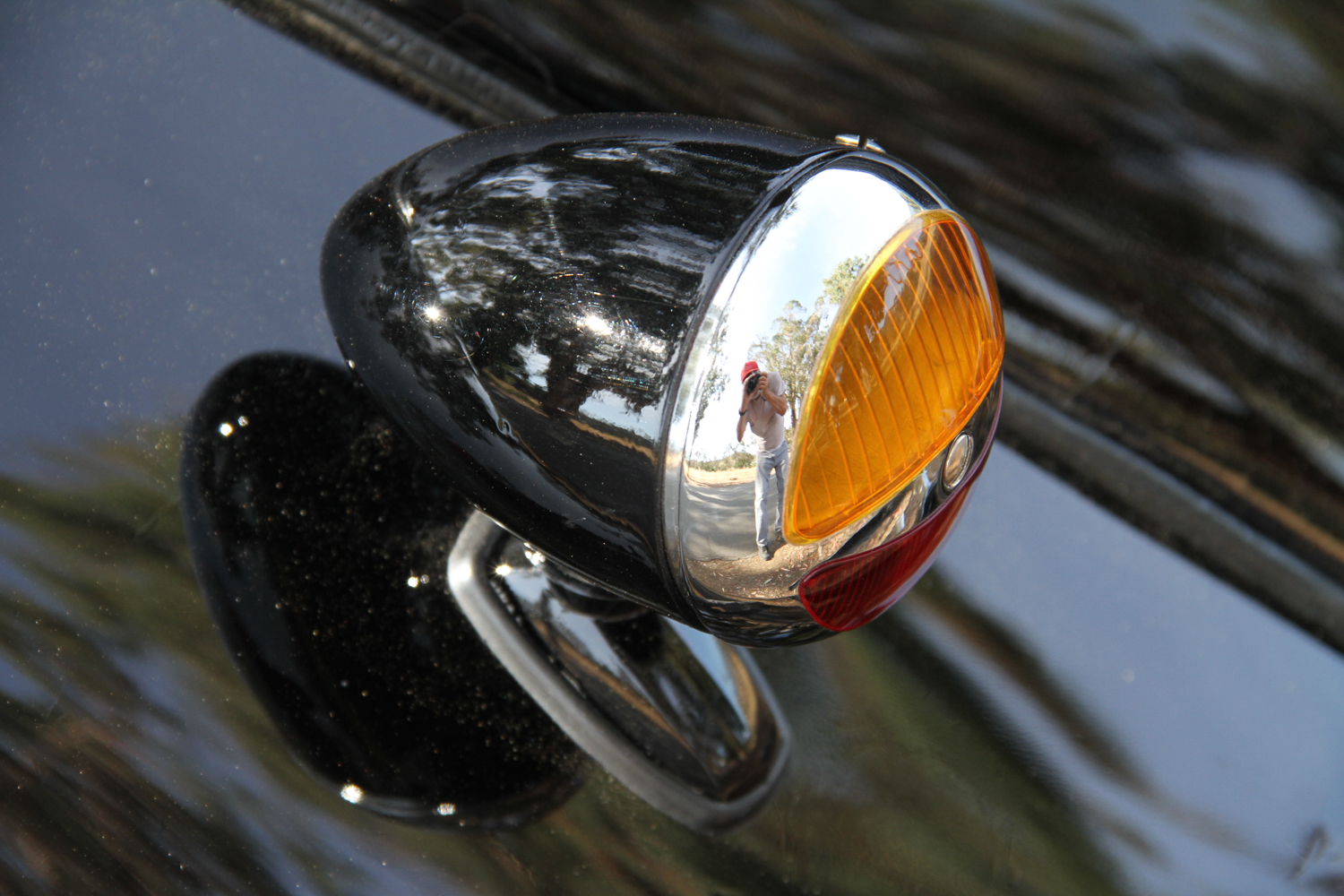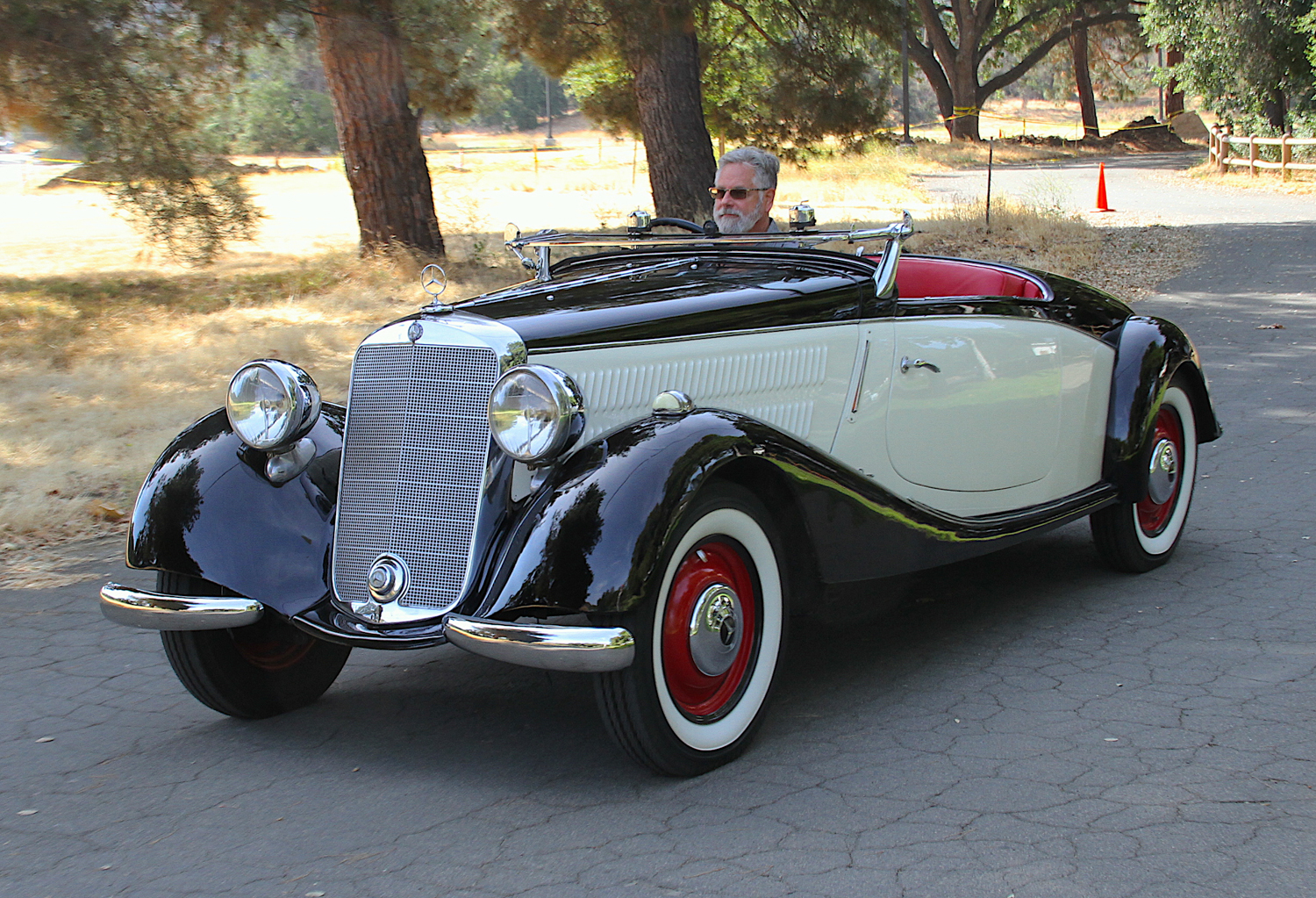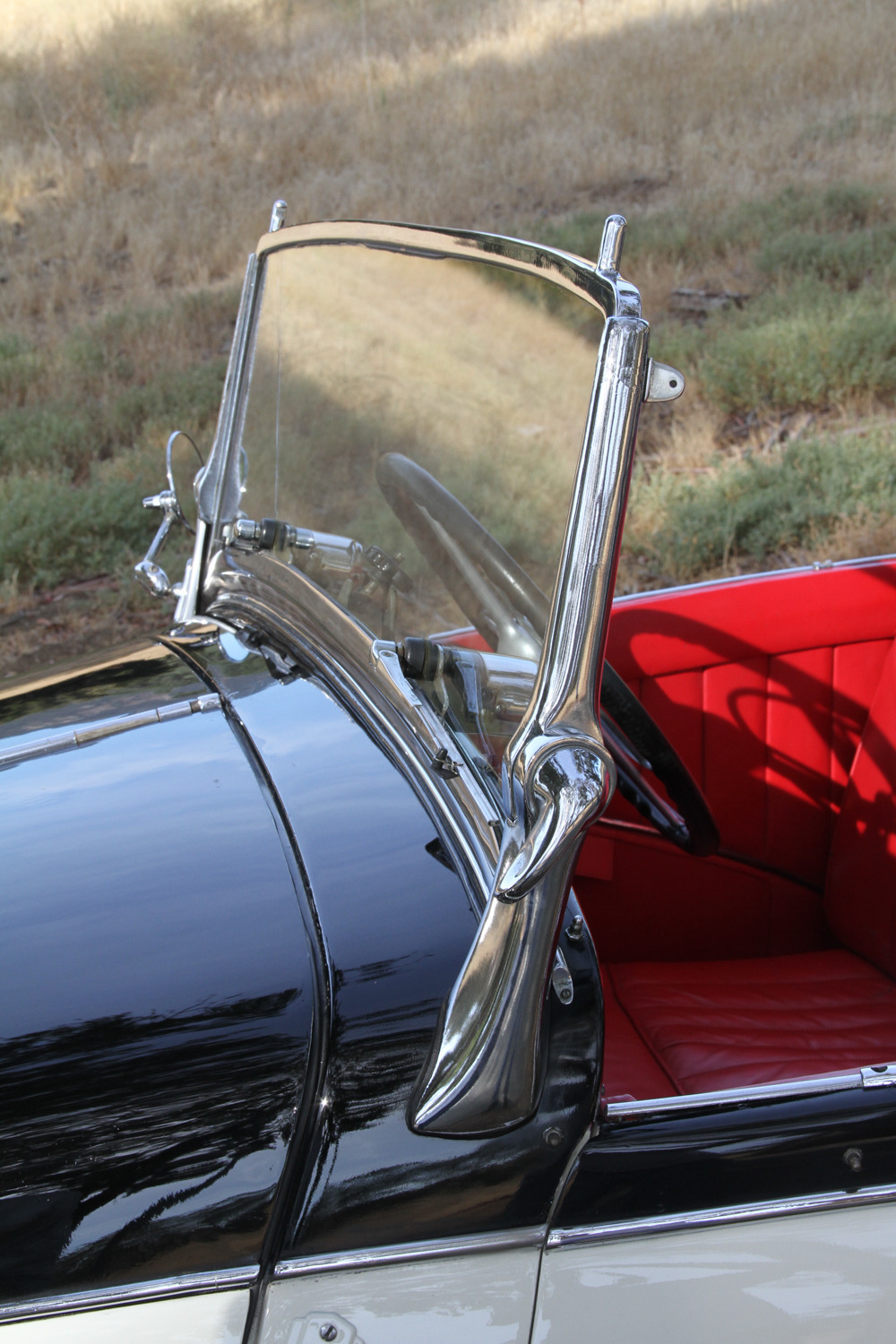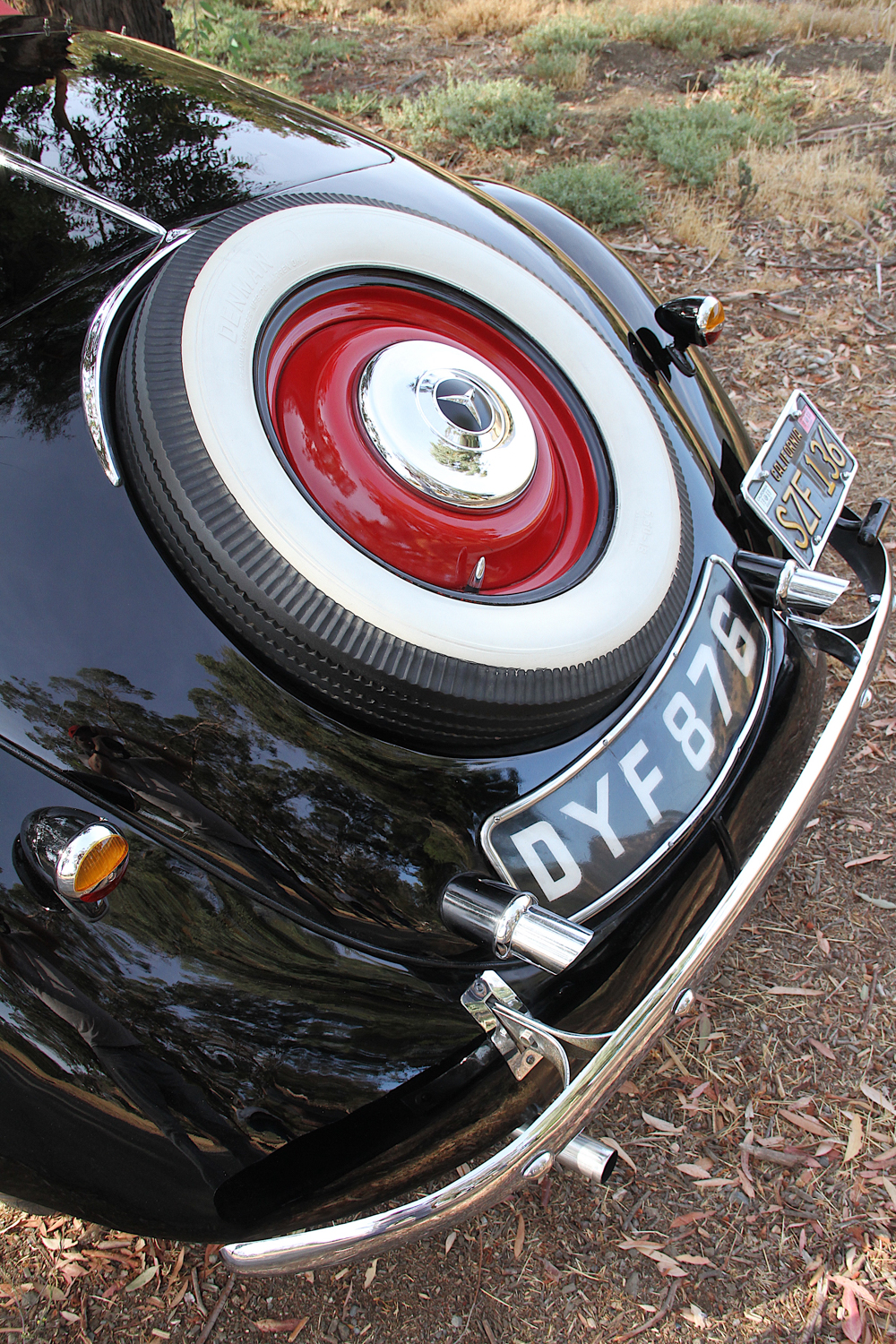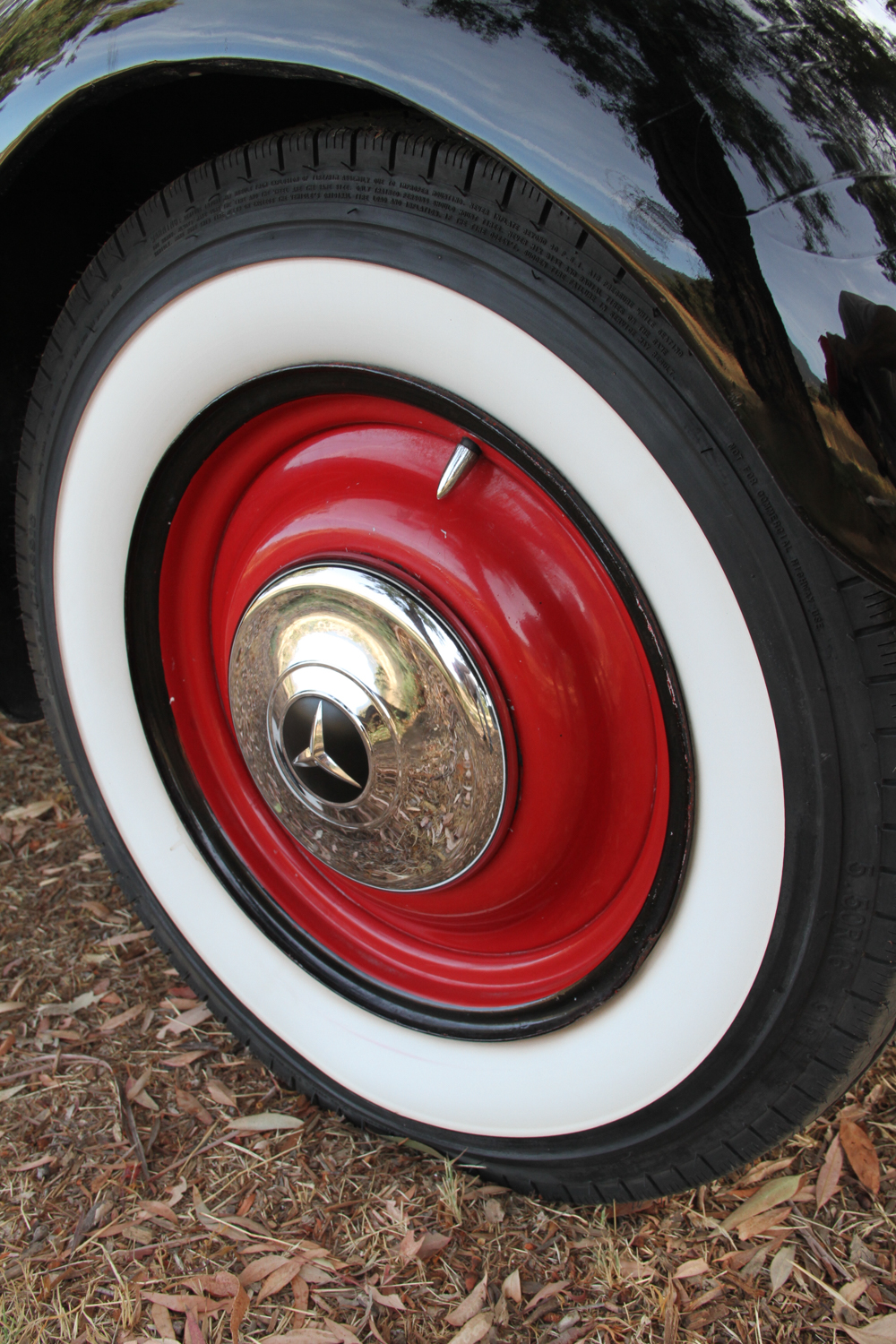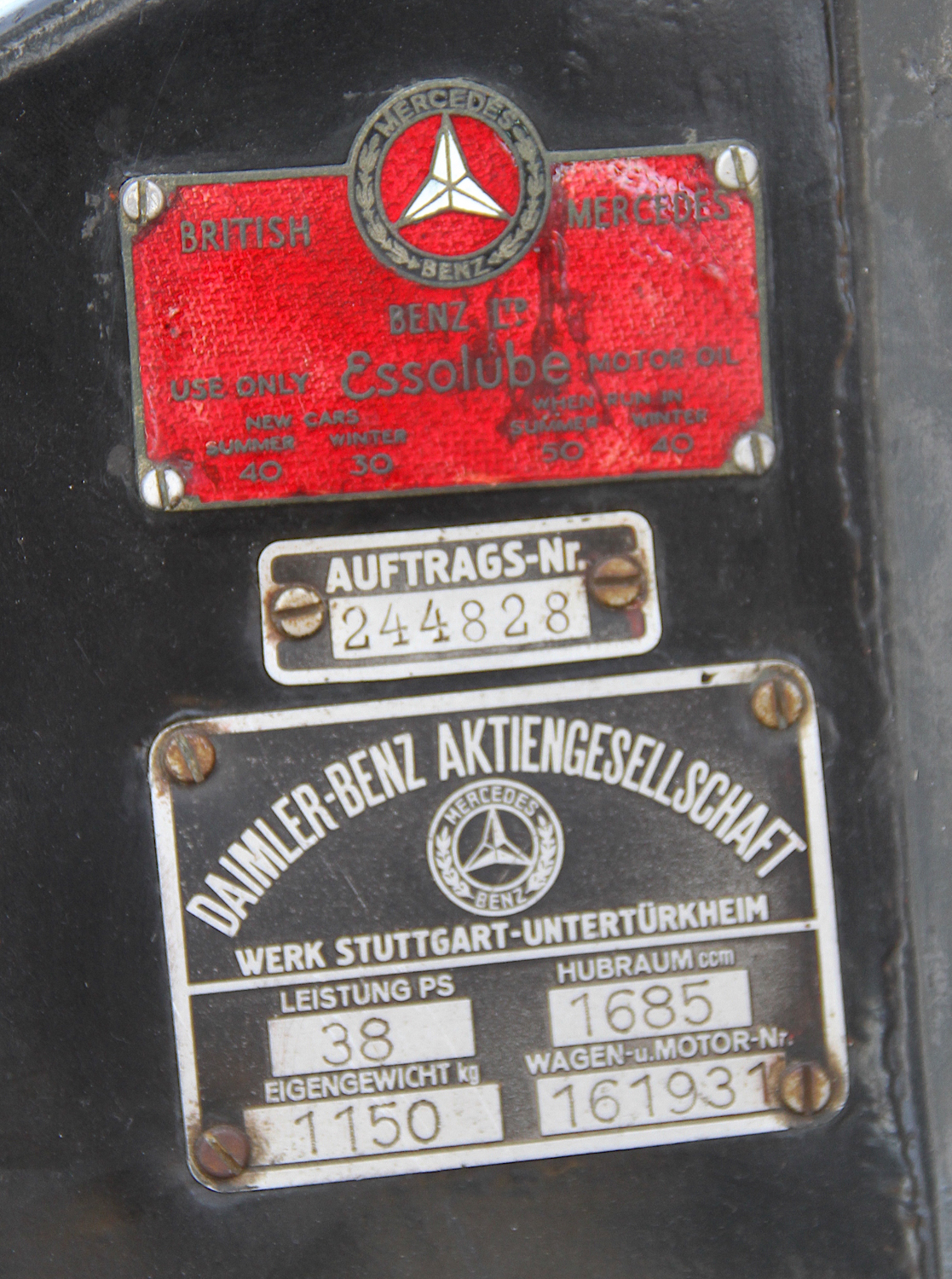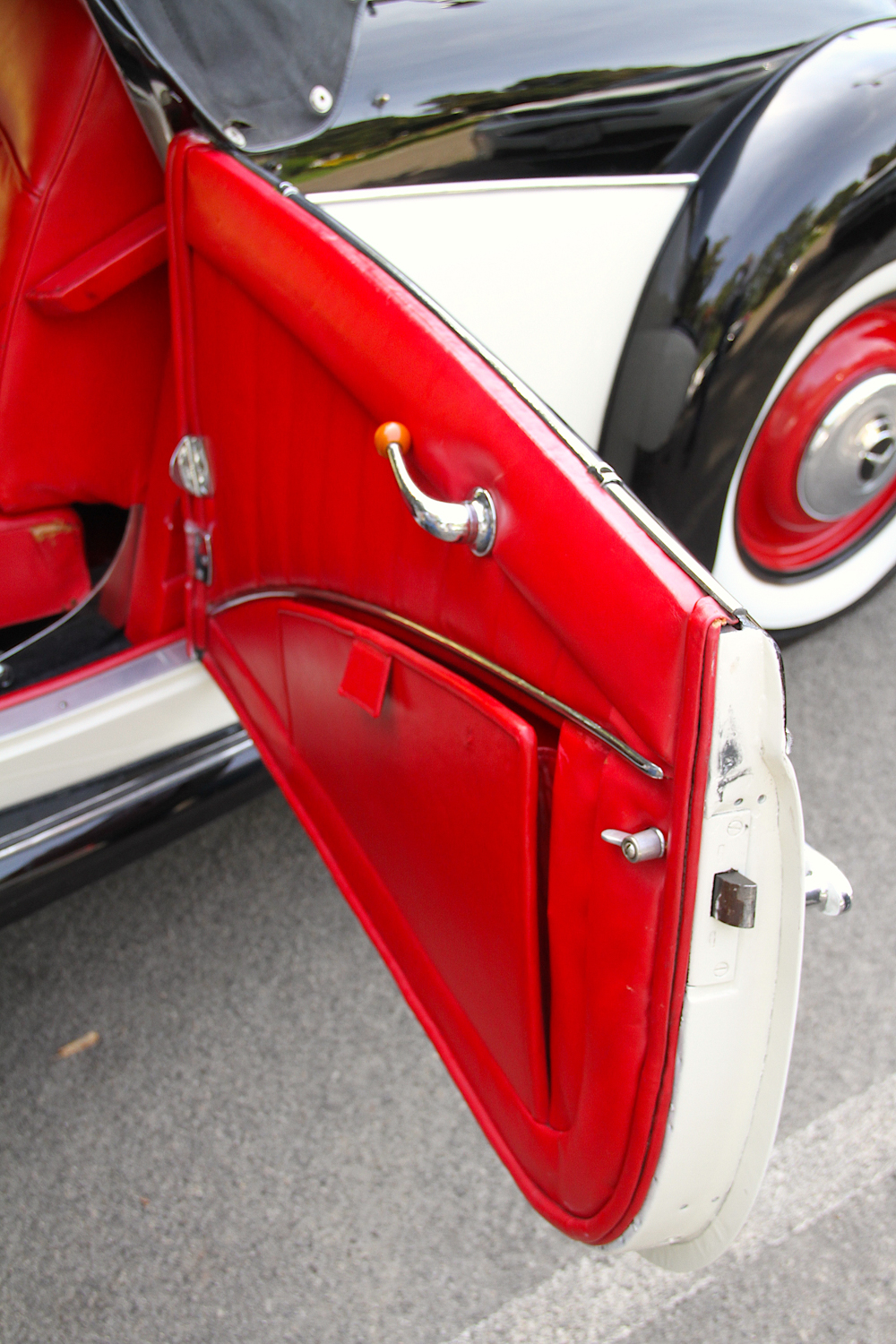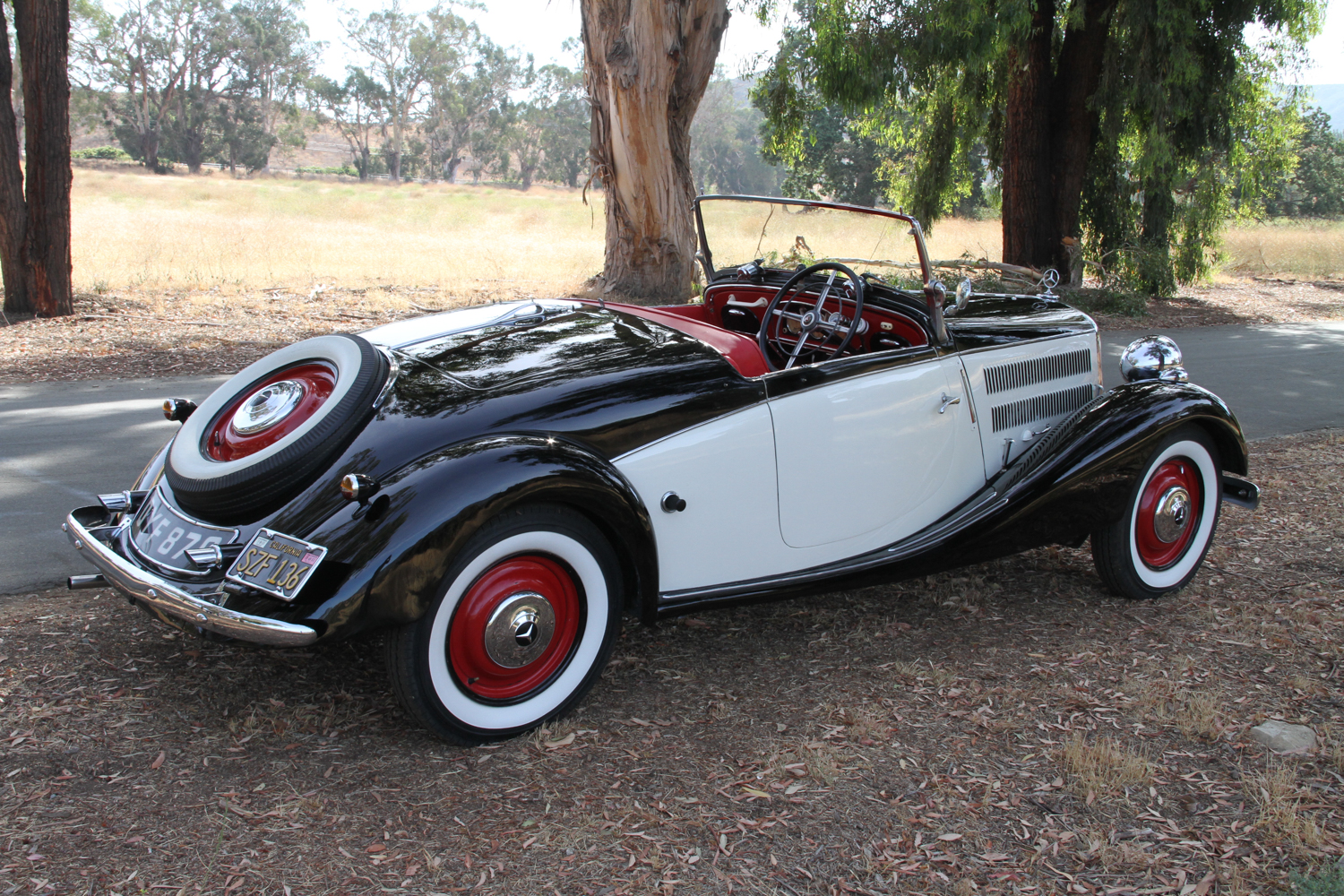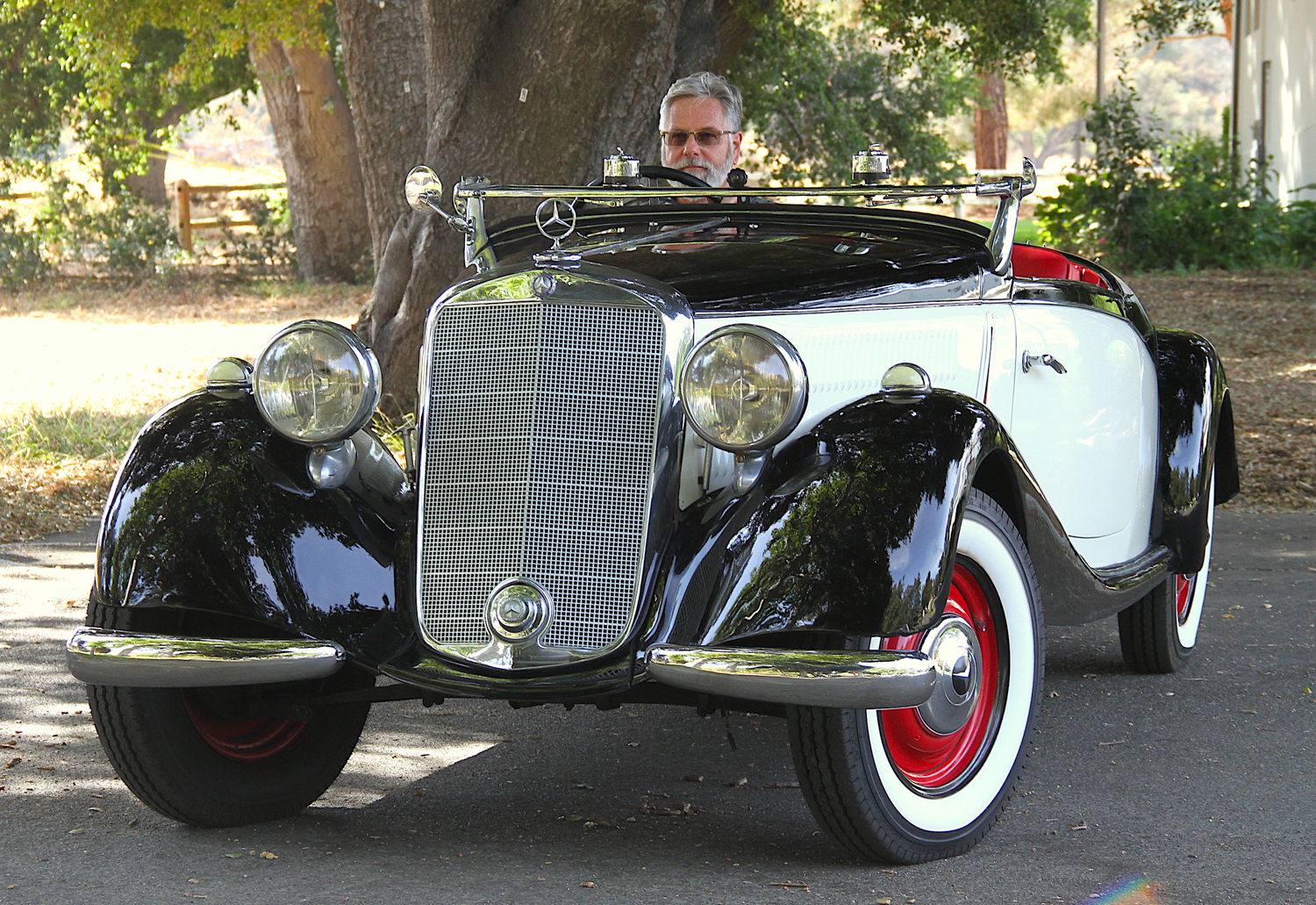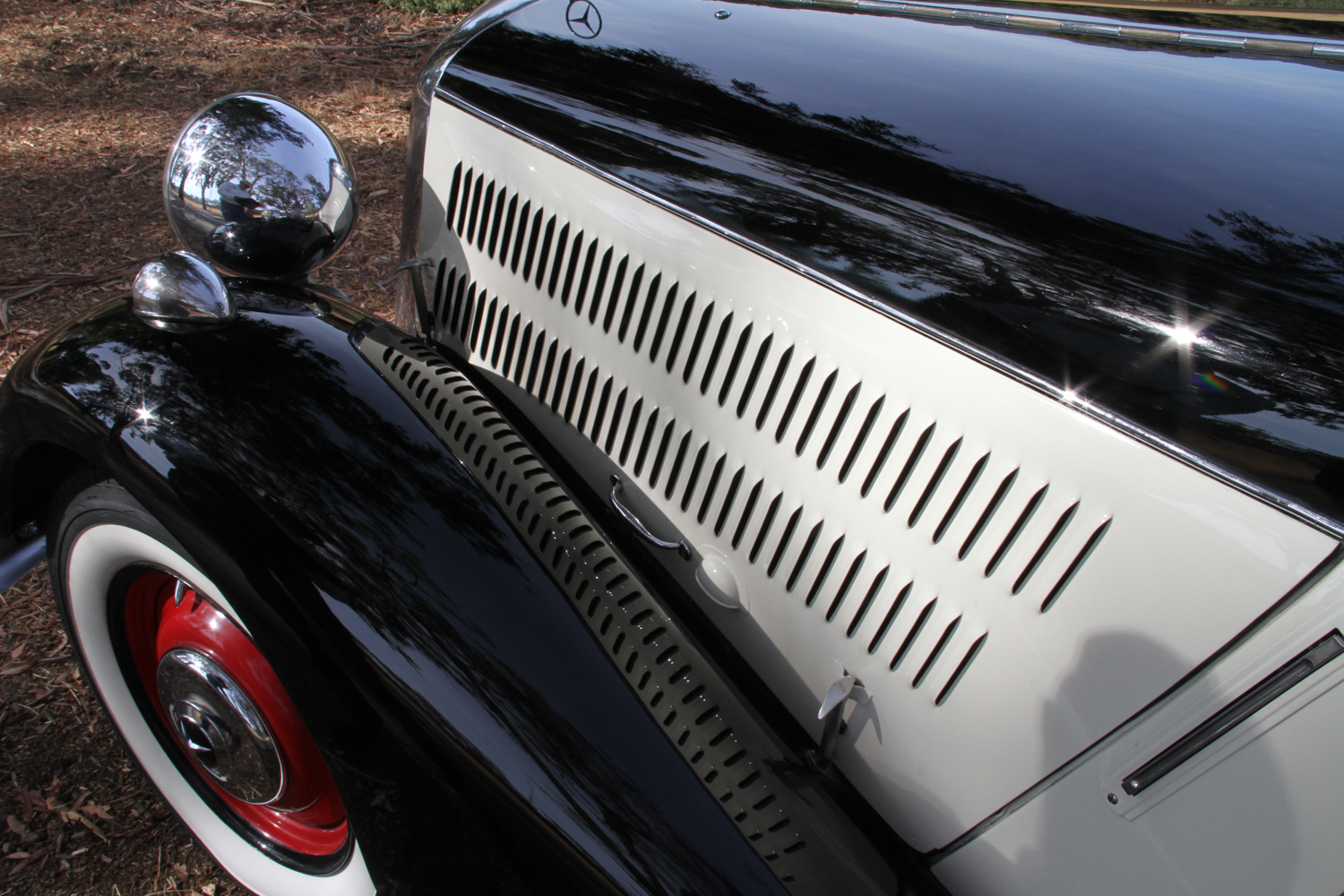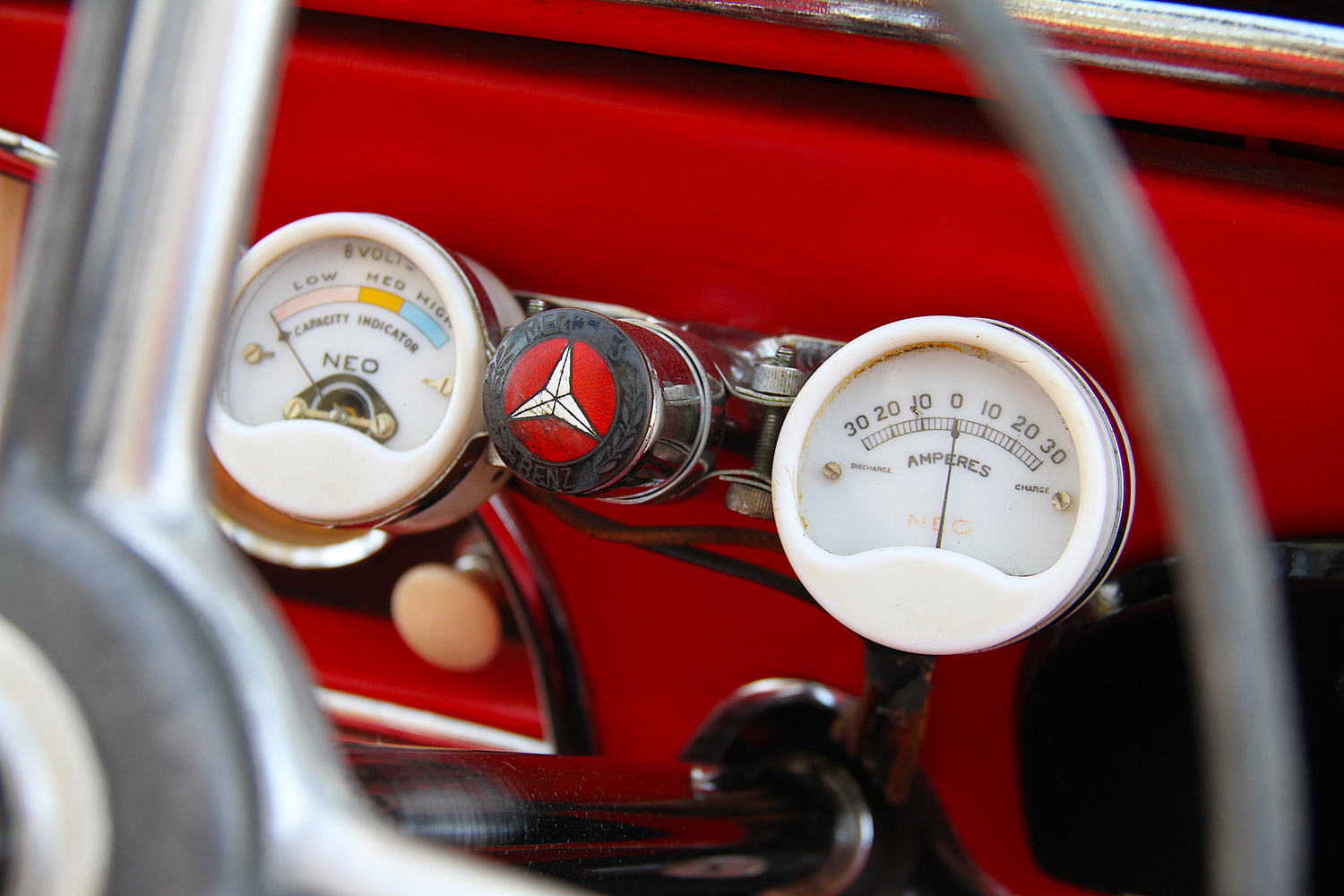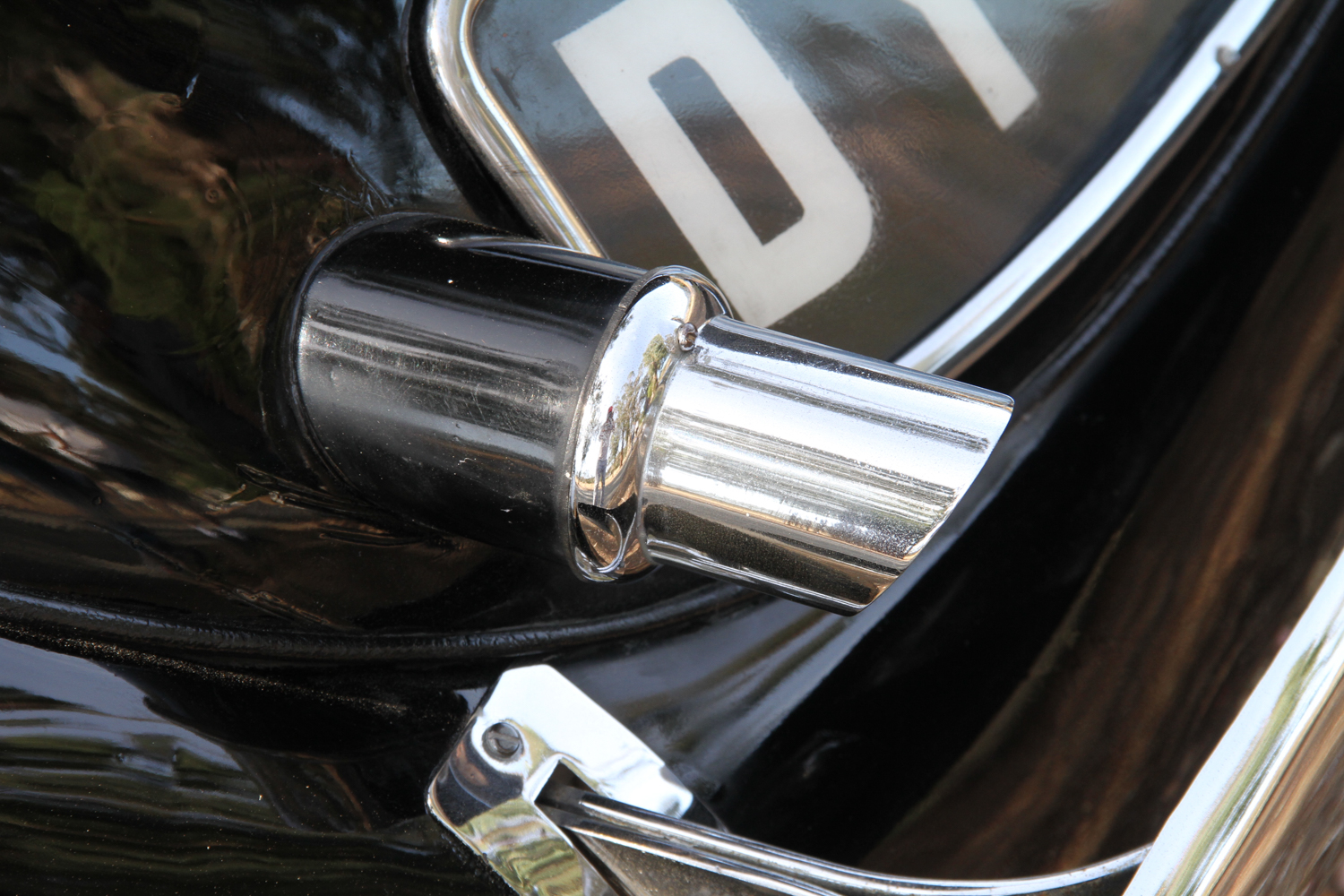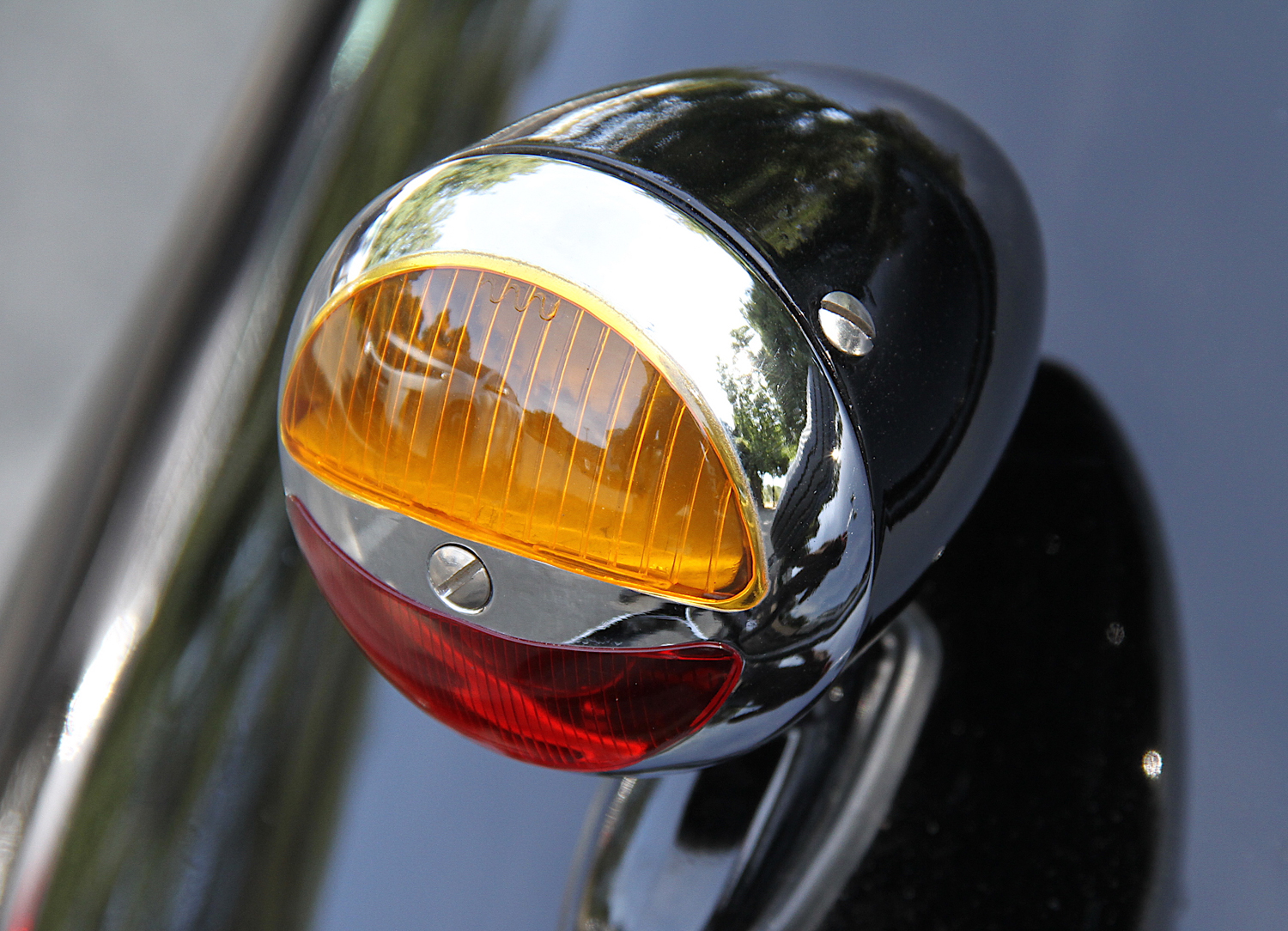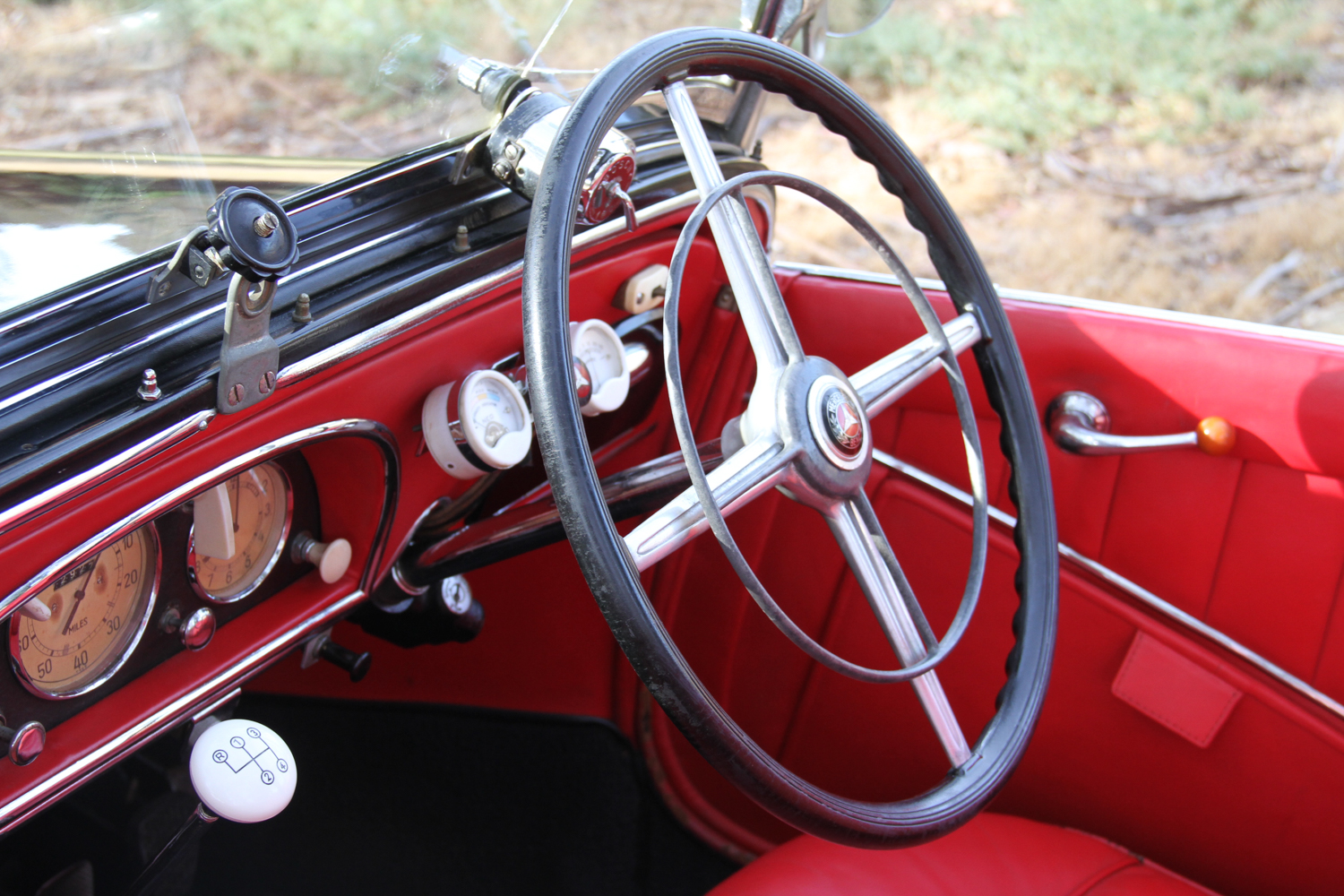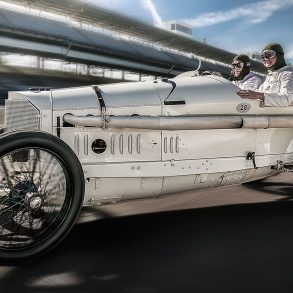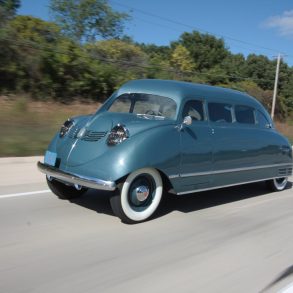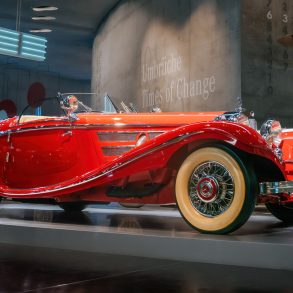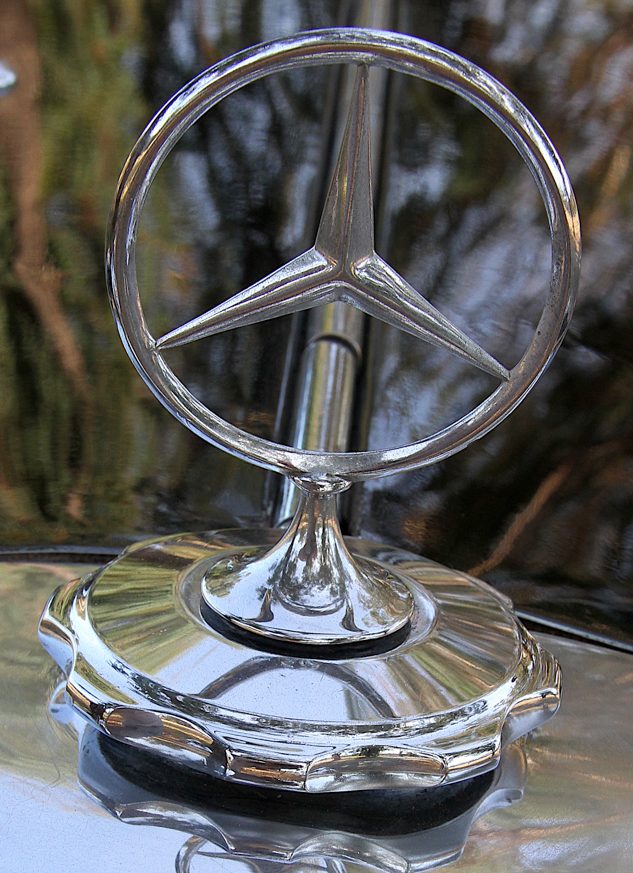
We were there to have a spin in this dashing vintage sports car, and if possible, understand the remarkable journey it made through time and space to get here and now. It seemed extraordinarily improbable that such a car would wind up in California, half a world away, 80 years after it was built, essentially none the worse for wear.
After introductions, followed by half an hour of oohing and ahhing, and looking over this amazing example of between-the-wars Mercedes design and technology, Gary tosses me the keys and I climb in and start the 103.4-cubic-inch, 4-cylinder flathead engine. It is still warm and comes to life instantly with a muffled bark before settling into a smooth idle, with just a subtle hint of valve train ticking. The instrument panel has all of the requisite gages, and they are big and easy to read. I watch as they do a little dance that tells me all is well.
The interior is intimate, width-wise, but there is plenty of legroom and an ample foot well. I pull the rather long shift lever back and down into first gear, and we are off. There is a satisfying hint of mechanical whir as the driveline does its business, reassuring me that I am in a sporty masculine machine.
Acceleration is good, but we run out of revs pretty quickly by modern standards, so I go for second, which is a fairly long gear that gets us up to cruising speed on the narrow road leading to the highway. It is a beautiful day, and the smells of the trees and sage add to the open car ambience.

Handling is nothing short of superb for a depression era automobile because the 170V comes with a sophisticated independent front suspension system first used on the French 1907 Sizaire et Naudin that employs transverse twin leaf springs. And in the rear the 170V has swing axles with coil springs.
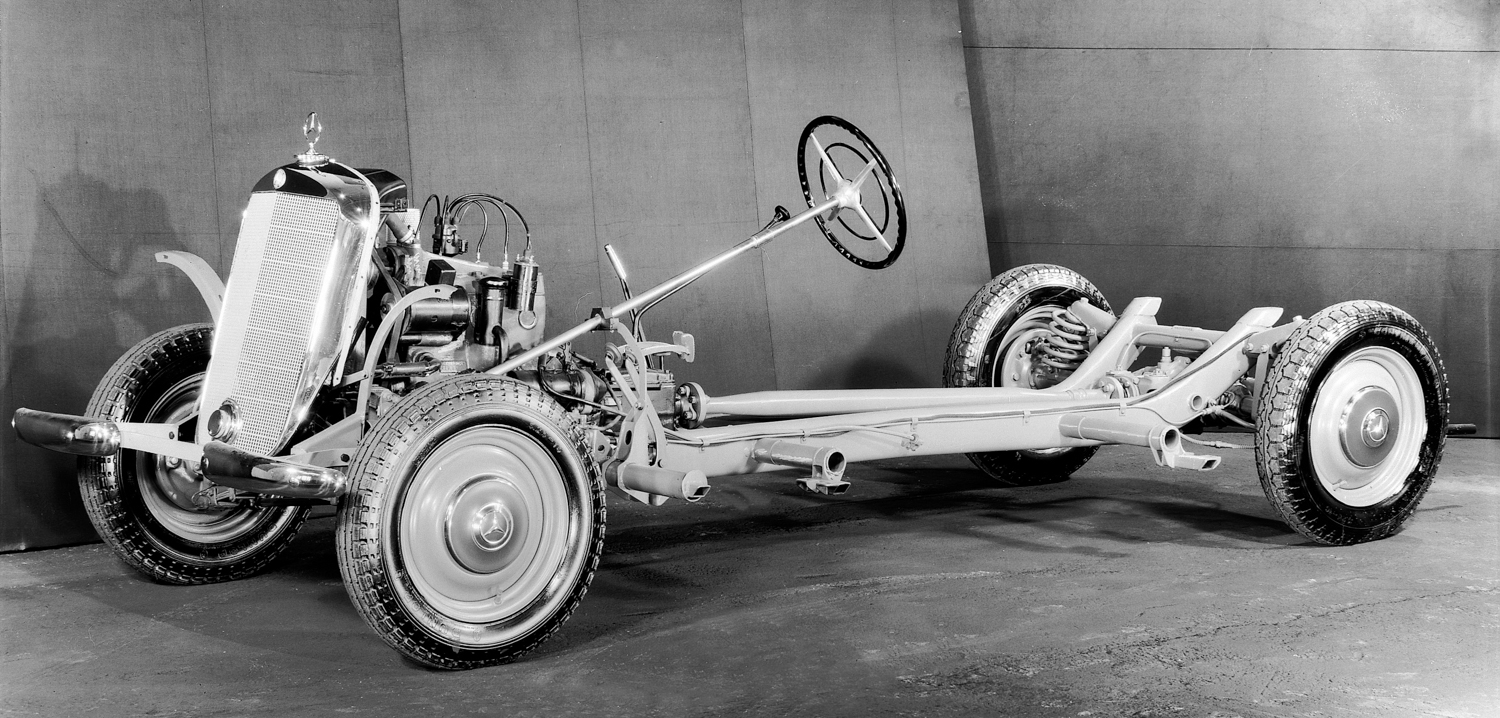
The 170V chassis was designed by legendary engineer Hans Nibel, who was responsible for many innovations at Mercedes during the 1930s. The Cabriolet’s custom coachwork was by Herman Ahrens who was responsible for the stunning 540K roasters, as well. Also the Cabriolets were built at Sindelfingen, not Stuttgart.
Braking is excellent, making our jaunt through the countryside thoroughly enjoyable and predictable at moderate speeds. Europe in the nineteen thirties had good primary roads, but just as in the U.S., the secondary roads were marginal, making a well designed, rugged suspension system and good brakes a virtual necessity.
We swing out onto the highway and take the little roadster up through the gears. And though it is no hot rod with its humble 38 horsepower, it accelerates nicely, and is capable of an honest 67 miles per hour (108 kph) without drama. Also, typical of Teutonic automotive engineering of the period, it is under-stressed and over-built by world standards. We could probably cruise pedal to the metal all day long.
Some might see the little 4-cylinder flat head engine as a bit primitive when compared with the engines in Mercedes’ more expensive cars, but consider this, the flathead design allowed for a sturdy, short valve train that seldom needed attention, unlike the overhead valve push rod engines of the time that required regular adjustment. Besides, the octane rating of the fuel back then was low, so the L head configuration worked fine. The problem with flathead engines later was that their compression couldn’t be increased beyond about 8.5:1.
With the top down, wind and noise is not a problem for the driver, assuming the windshield is in the upright position, but it is not as serene for our photographer riding in the rumble seat. He shouts that it is quite roomy and comfortable, but he does have to hold on to his hat while shooting. Gary and I, however, are able to converse easily though. The car’s ride is firm but comfortable, just as a sports car should be.
Cars come flying by on the other side of the highway and people wave, while others overtake us and lean out to take pictures with their cell phones. I imagine this car always attracted attention because its custom body is a bit on the brash and flamboyant side, with touches of swoopy French styling, as opposed to the more upright and soberly appearance of the 170 series closed sedans.
The car’s paint scheme is striking too, with its black and ivory two-tone, with red wheels as accents. In front is the handsome and iconic Mercedes radiator housing with the three-point star riding high on the radiator cap. And in the rear, the car’s original custom British license plate echoes the shape of the continental spare on the rounded tail of the car.
When most American car buffs think of between-the-wars Mercedes today they picture the huge mighty, one-off custom-built supercharged automobiles driven by the elite; or their minds wander to the race-winning masterpieces that were only topped in speed a relatively few years ago; but it was the smaller production models such as the 170 and 170 V that were Mercedes’ bread and butter at the time, and again immediately after World War II.
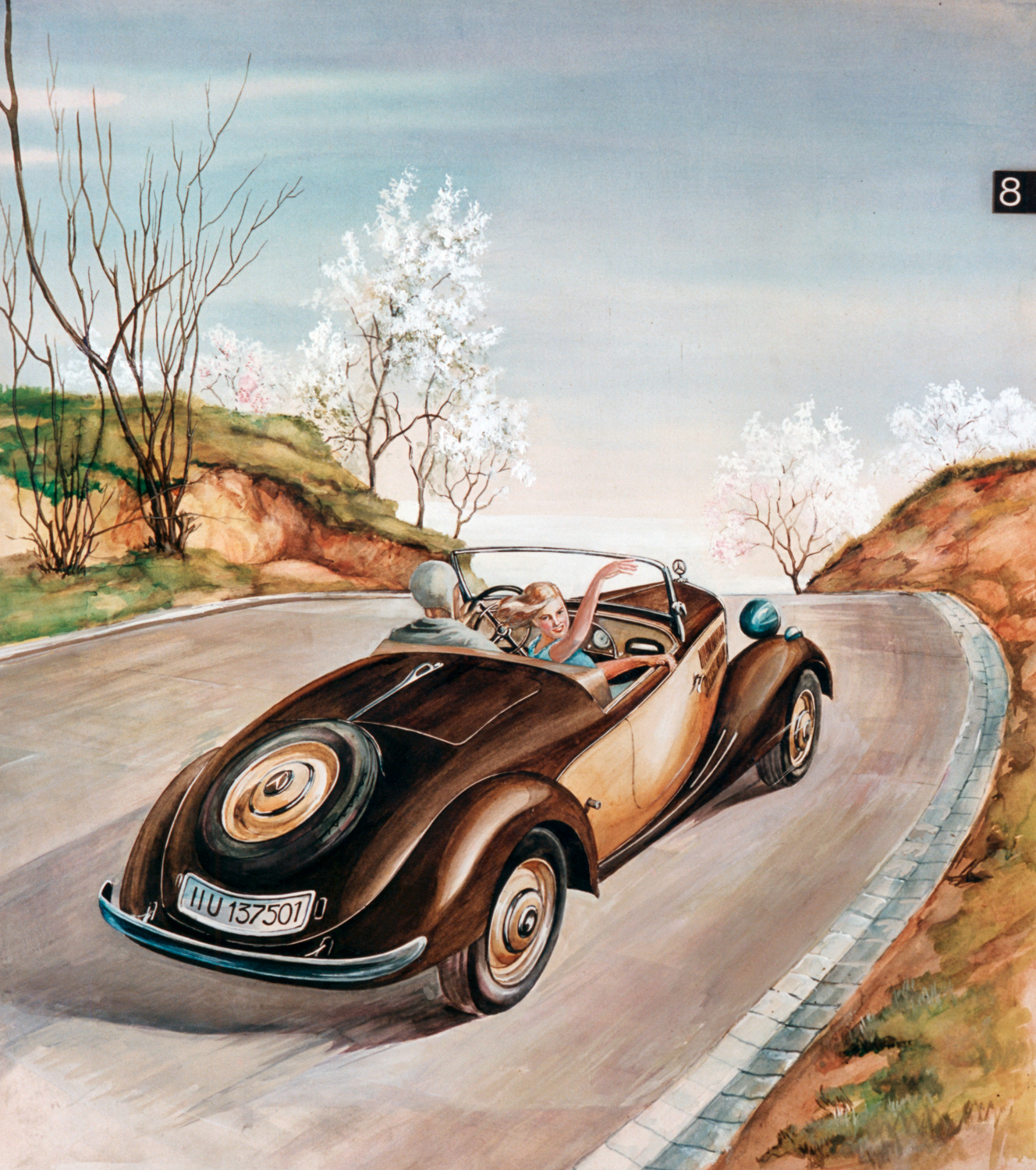
Thanks to German engineering, build quality and clean styling, the 170 series cars sold very well in Germany, as well as abroad— Humecke’s example being evidence of this assertion. The little roadster was ordered by someone in the United Kingdom, as is apparent from its right-hand steering and the original Lucas headlights that were on the car. Obviously, the British had their own ideas about safety in those days.
The 170 V Cabriolet was not in the same league as the classic British Rolls-Royces, Lagondas and Brough Superiors, but the Cabriolet was by no means a humdrum mass-produced car for the masses either. The bottom-end 170 V two-door sedan could be purchased for the equivalent of a mere U.S.$684, but Humecke’s custom bodied Cabriolet A would have set you back a tidy $1435, which put it in the range of a Buick, or a LaSalle, Cadillac’s companion car of the era.
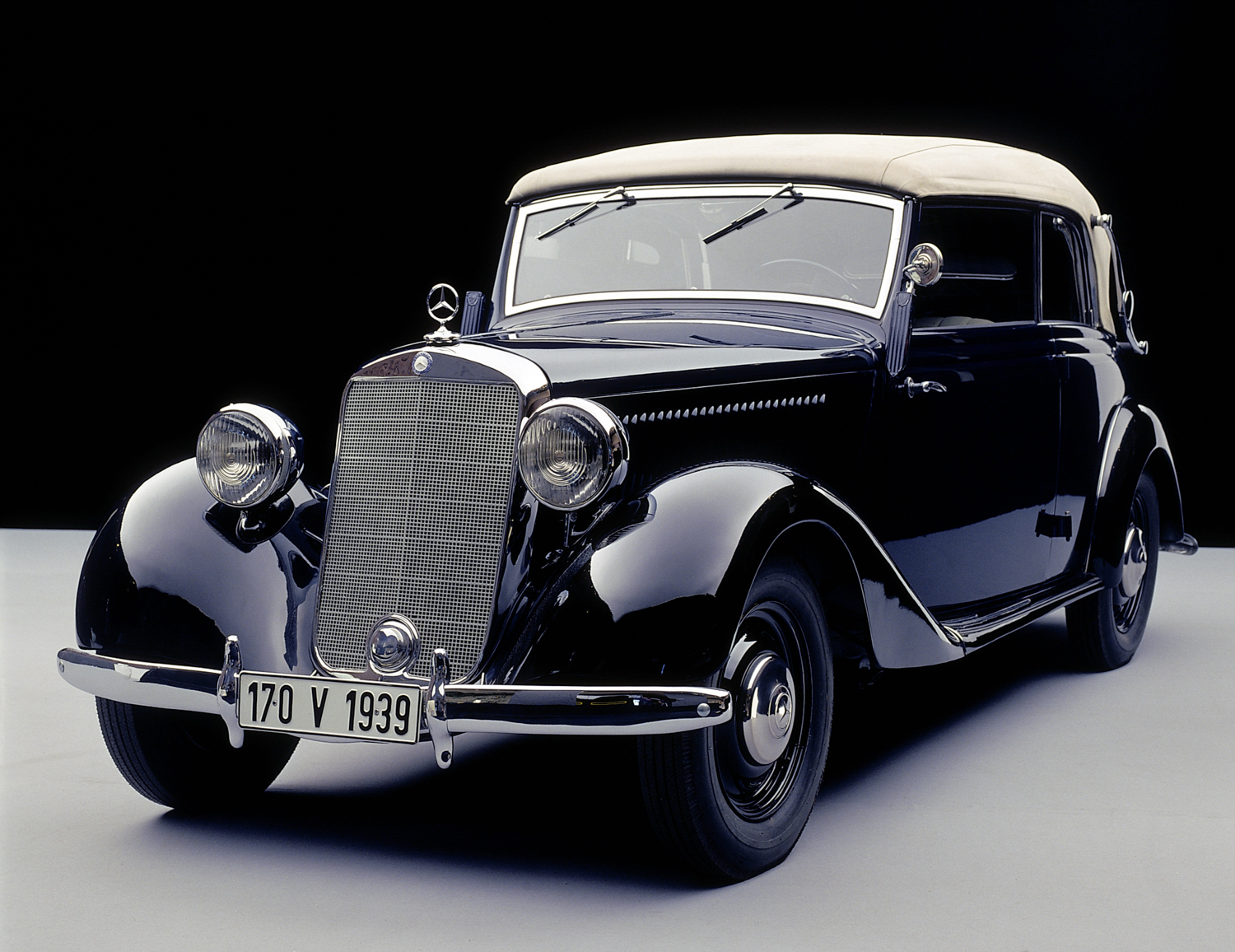
The standard 170 V sedans were a spectacular sales success, though the Cabriolet didn’t do as well, with only 271 being sold before the war. As a result of limited sales and the intervention of World War II, it appears that there are only 12 of these pre-war roadsters left, which makes it all the more remarkable that this example is here in almost showroom new condition.

Some liken Mercedes Benz to Rolls-Royce and Bentley, but the company became – and still is – more like the American carmaker Packard, the prestige marque that custom built exquisite 12-cylinder luxury cars for the privileged, but during the depression also produced less opulent mid-priced cars as well.
And like Packard, whose less costly mass-produced junior models carried them through the depression, Mercedes’ 170 from 1931 and the 170V from 1936 kept the company going through the hard times of the ’30s, when there were relatively few orders for hand-built touring masterpieces and racecars.
Both companies had a reputation for quality and conservative elegant styling. The difference being that after the war, Packard lost the high ground to Cadillac and devoted their efforts to mid-priced mass-produced cars, whereas Mercedes maintained their sterling reputation and built on its status while continuing to be the prestige marque it is today, all while simultaneously building their popular mid-priced offerings.
Little is known about Gary Hummock’s 170V Cabriolet before it wound up in Bud Cohn’s collection in the States, but one clue as to when its journey to the new world might have taken place is that it has American Denman tires on it dated 1944, which may indicate that it made its westward journey either before, or during World War II.
If I were to let my imagination have free reign, I would speculate that a high-ranking American official— perhaps an officer in the military, or a diplomat— brought it back with him, and that he had the clout to be able to equip it with new tires at a time when they were strictly rationed for the war effort. Of course, it is also possible that the Denman tires are much newer than the date embossed on them, but were made using molds from that period.
A gentleman bought the car from Cohn, in 1968, for a well-to-do lady in Hollywood, California, who was unfamiliar with standard shift and never drove it. As a result, she promptly parked it in a garage where it sat for the next 50 years! It was from her that Humecke bought the car, and he was surprised at how little he had to do to get it back on the road.
When Gary acquired the car its engine was seized, and when they removed its head, several studs broke off, which is a common problem for cars from the era that have aluminum heads and cast iron blocks. Electrolysis causes the studs to bond to the head and virtually welds it into place. After that happens, it is very difficult to get the head off without damaging it, along with the mounting studs. Gary was able to locate another head and installed it, and then he rebuilt the carburetor and generator before oiling it up and starting it.
The brakes were just fine, amazingly after the long years of storage, and only required a fluid change. The paintwork merely needed a little touching up. And indeed, after cleaning and detailing, the car looked new, and it now runs just like it looks. Driving it is like taking a step back in time, because it is so well preserved and original.
This 170 V Cabriolet is also equipped with a central-lubrication system operated by a pedal on the floor, much like the Bijur systems that were installed on American classics of the time. Also, the top disappears completely under the tonneau in front of the dickey seat, making it one of the priciest models. The gas tank is uniquely mounted against the firewall, and can only be accessed by opening the hood, as was common for smaller German cars from this period.
Gary’s sporty roadster would have been quite eye catching in pre-war Britain, racing along on the narrow two-lane roads and flying past the hedgerows in the English countryside. I picture an aristocratic playboy of the “better sort”, with a jaunty cap, corduroy jacket with elbow patches, scarf trailing in the wind, a pretty lass by his side, as he glides along immersed in the moment, not realizing that his way of life was about to change in unimaginable ways, oblivious to the future that is fast approaching.
And then, perhaps a few years later, I can envision the 170 V being lowered onto a freighter destined for New York and a new life with its new owner. But then shortly after that, the car is laid aside for nearly a lifetime, and incredibly now, 80-plus years after it was built, it is being appreciated all over again for the beautiful and unique machine it is.
We wind back through the bucolic two-lane country roads around the Thousand Oaks area and return to where we met up. It is late afternoon by now and the light all around us is warm and soft, causing our photographer to lapse into a frenzy of shooting, and uttering words like “yesss!” and “got it” and “Look at this” and then holding the camera so we can see what he has captured.
We shake hands, and I thank Gary as we reluctantly pile into my old Saturn and head for home on the crowded freeways, thinking about a day that seems almost unreal but beautiful and exciting. Even seasoned automotive journalists don’t get rides in such well-preserved, unique and enjoyable machines as this Cabriolet very often.
SPECIFICATIONS
| Length | 4,270 mm / 168.1” |
| Width | 1,570 mm / 61.8” |
| Height | 1,560 mm / 61.4” |
| Wheelbase | 2,845 mm / 112” |
| Engine manufacturer | Daimler-Benz |
| Engine type | Spark-ignition 4-stroke |
| Fuel type | Gasoline |
| Fuel system | Solex 30 BFLVS single barrel carburetor |
| Induction | Naturally aspirated |
| Valves per cylinder | 2 |
| Cylinders alignment | Inline-4 |
| Displacement | 1,697 cm3 / 103.4 cui |
| Horsepower net | 28 kW / 38 PS / 38 hp (DIN) |
| Torque net | 100 Nm / 74 ft-lb |
| Car power to weight ratio net | 23.3 watt/kg / 10.6 watt/lb |
| Fuel tank | 33 liter / 8.7 gallons |
| Weight | 1,200 kg / 2,650 lbs |
| Top Speed | 108 kph / 67 miles per hour |




